Whanganui Arts in Review: A Survey of Past Award Winners 2011- 2021
The Pattillo Whanganui Arts Review has been showcasing the diverse works of Whanganui artists for the last thirty four years. It is the longest running public arts review in New Zealand, and is a highlight of the Sarjeant’s annual programme. This exhibition showcases new work by the main winners of the past decade.
On show at Sarjeant on the Quay and online HERE until Sunday 5 June 2022
Most of the works in this exhibition are for sale. Click the MAKE A PURCHASE ENQUIRY button to find out more.
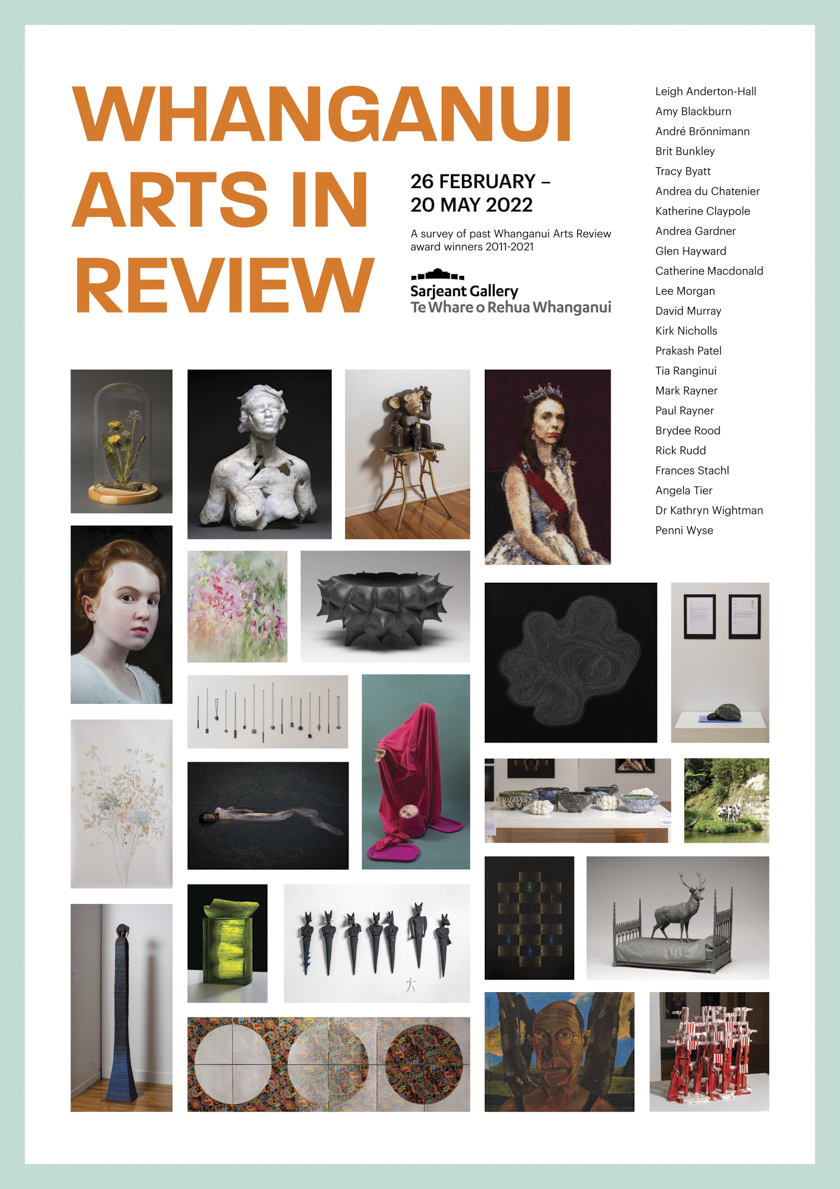
This limited edition poster is available at Sarjeant on the Quay
The Whanganui Arts Review has been showcasing the diverse works of talented artists from the Whanganui region for the last thirty four years. As the longest running public arts review in New Zealand, we value this exhibition as a highlight of our annual programme. We also enjoy recognising artists that have made an outstanding contribution to the Review with an array of awards, sponspored by local businesses and our principal sponsor Pattillo. Whanganui Arts in Review is a survey of award winners from the past ten years, 2011-2021.
This year we have moved the Arts Review to November due to programme rescheduling caused by the uncertainties surrounding Covid 19. In its usual place in the calendar, we wanted to offer a glimpse into the current practice of artists who have won either the Open Award of the Review, a Highly Commended or an Excellence Award from the last decade. The resulting selection brings together works by twenty three distinctive artists, and reflects their practice since winning an award.
We have last year’s Open Award winner and Pattillo Project recipient Andrea Gardner represented with her characteristic staged photography, alongside recent photographic works by Tia Ranginui, Brydee Rood, and a video and 3D printed sculpture by Brit Bunkley. The local ceramic community is present in the vastly different works of Leigh Anderton-Hall, Andrea du Chatenier, Rick Rudd, and Angela Tier, displaying the versatility of this wonderful medium. The skilled art of jewellery can be found in a new body of work by Frances Stachl.
Whanganui’s glass community is exhibited with beautiful works by David Murray and Dr Kathryn Wightman, with sculptural and installation works by Tracy Byatt, Glen Hayward, Lee Morgan, Kirk Nicholls and Penni Wyse. Drawing and painting are also well covered with the varied works of Amy Blackburn, André Brönnimann, Katherine Claypole, Catherine Macdonald, Prakash Patel, Mark Rayner and Paul Rayner.
We hope you will enjoy discovering the work of the many accomplished and thoughtful artists who call Whanganui home, and look forward to welcoming you to our annual Pattillo Whanganui Arts Review when we open this ever-popular exhibition later this year.
Jessica Kidd, Assistant Curator
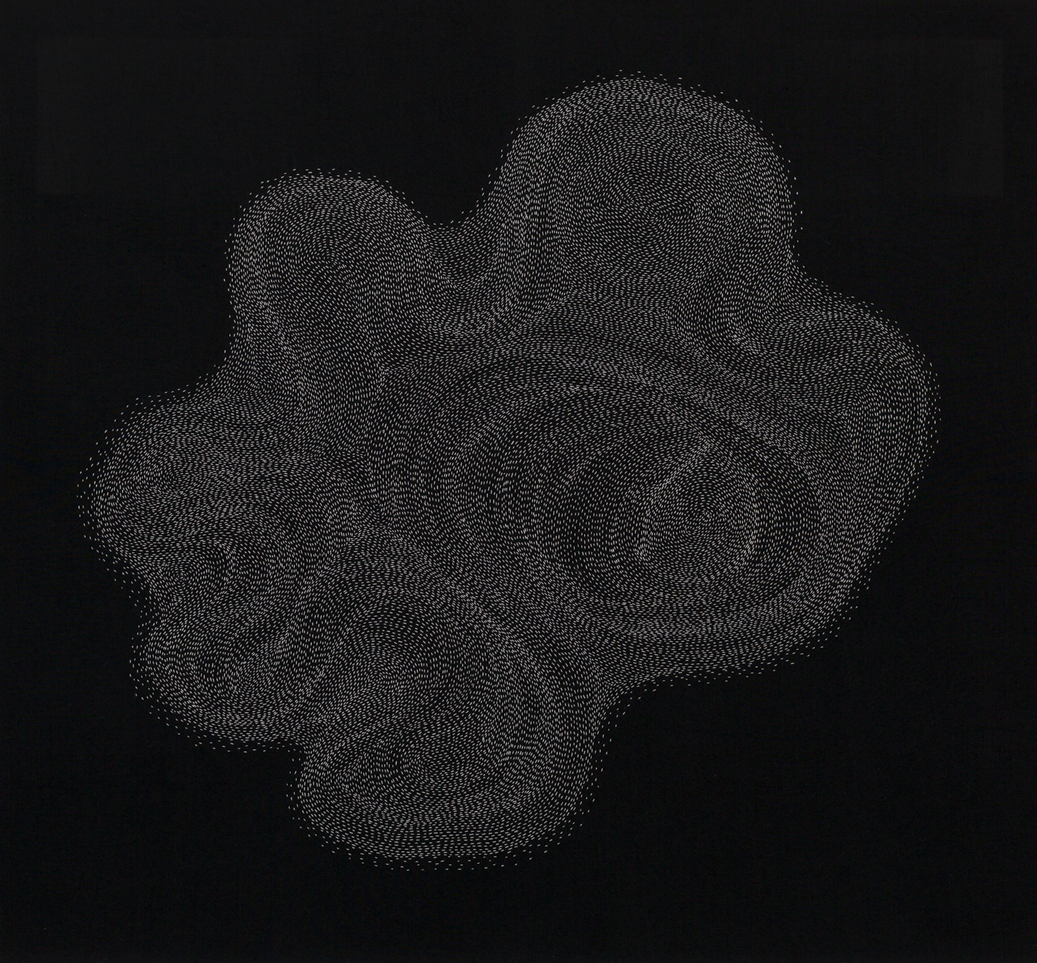
Katherine Claypole
Kinesthesia 2021
cotton thread on stretched linen
Courtesy of the artist
“Since winning the award, I have given up using pencil and graphite
to draw with, in exchange for a needle and thread. In my most
recent works I employ stitched processes that are equal parts
obsessive and meditative, repeating small actions, gestures,
or marks until they coalesce into independent fields, flows,
structures, or spaces. My studio research has been based around
the science of vision, perception and optical phenomena.
Even with the eyes closed, one can perceive the movement of a
limb and its direction. The term kinesthesis (“feeling of motion”)
has been coined for this sensibility. In this artwork I wanted to
explore this perception of movement without seeing.”
Katherine Claypole was the recipient of the 2011 Carey Smith & Co Ltd Open Award
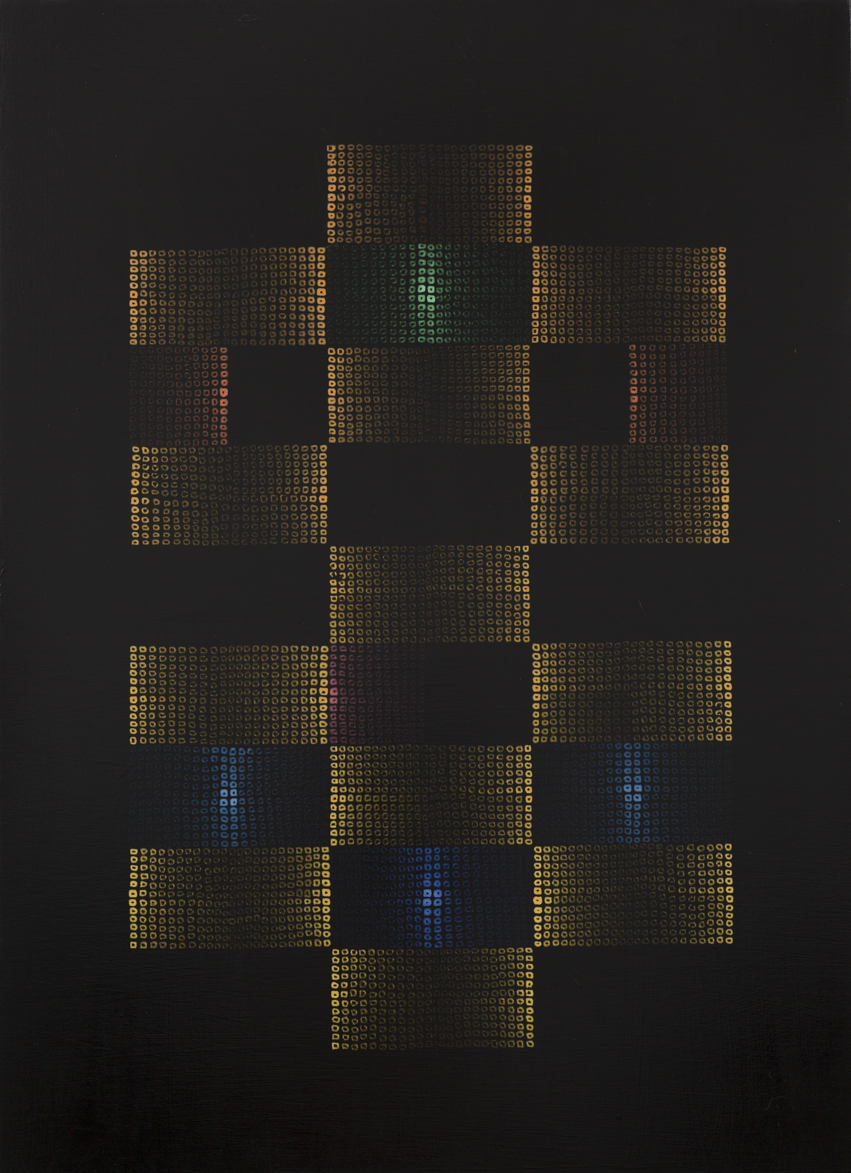
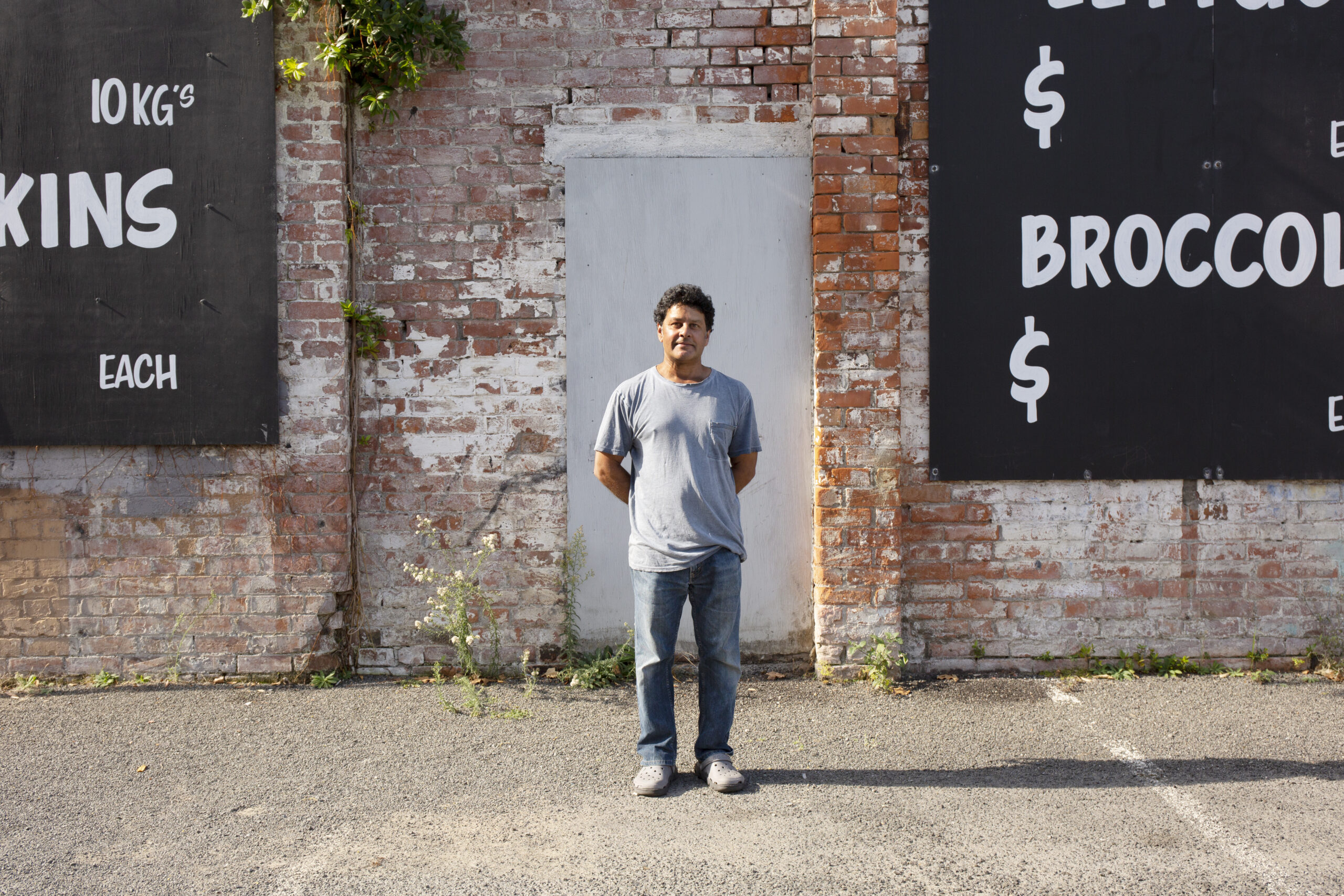
Prakash Patel
Prakash Patel
Sum 2020
acrylic on canvas
Courtesy of the artist
“Since the award I have tried to push my work towards more direct
and simplistic outcomes while still maintaining an intuitive style.
I’ve always been drawn to both simplicity and complexity, so my
paintings are sometimes random and aimless and other times
planned and methodical.
Currently my focus has been planning for a studio building closer
to home as I recently moved out of my Bedford Ave studio after
twenty five years.
The work displayed here is a selection of ideas I have developed
over the years. I’ve always enjoyed an experimental approach
to painting. For me each work is an adventure into the unknown
which keeps things challenging and exciting.
I think the role of the arts during this pandemic has done what it’s
always done which is that it reflects the human condition and the
environment we live in.”
Prakash Patel was the recipient of the 2013 Sarjeant Gallery Te Whare o Rehua Whanganui Open Award and the 2014 Bryce Smith & Associates Ltd Highly Commended Award
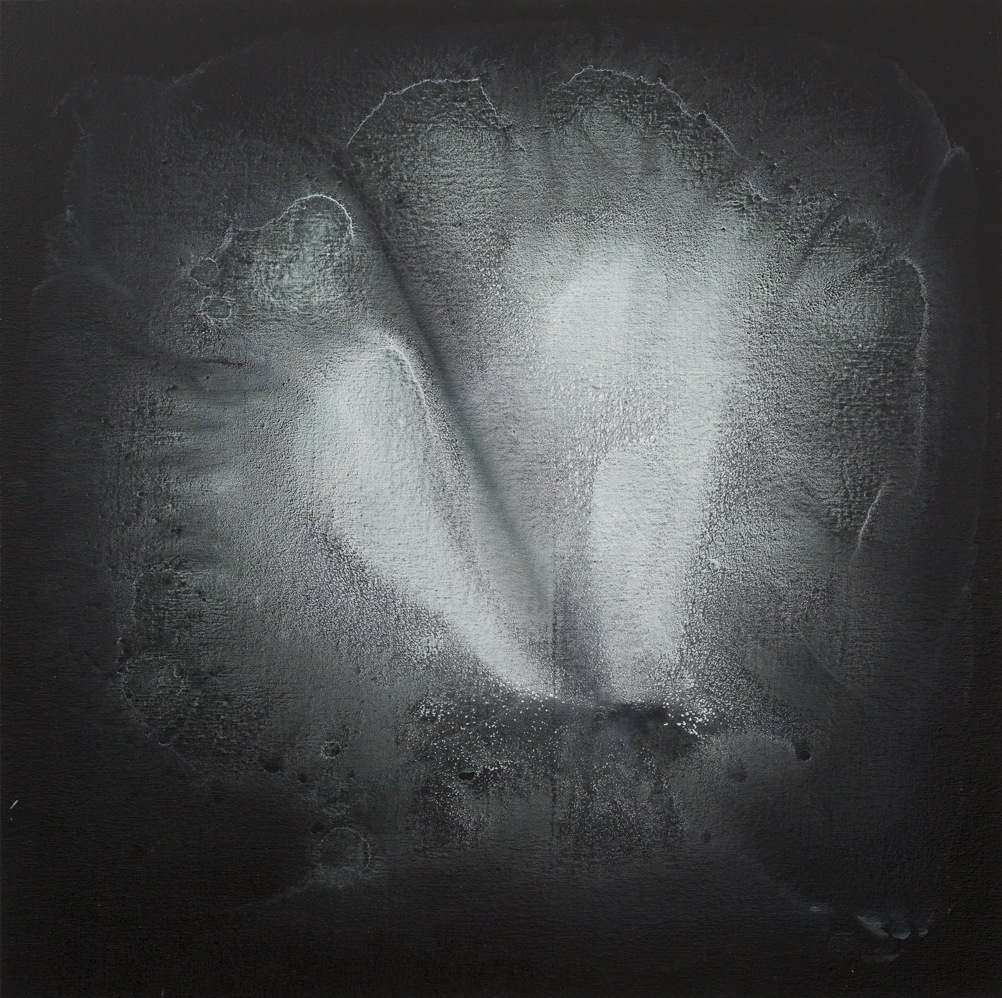
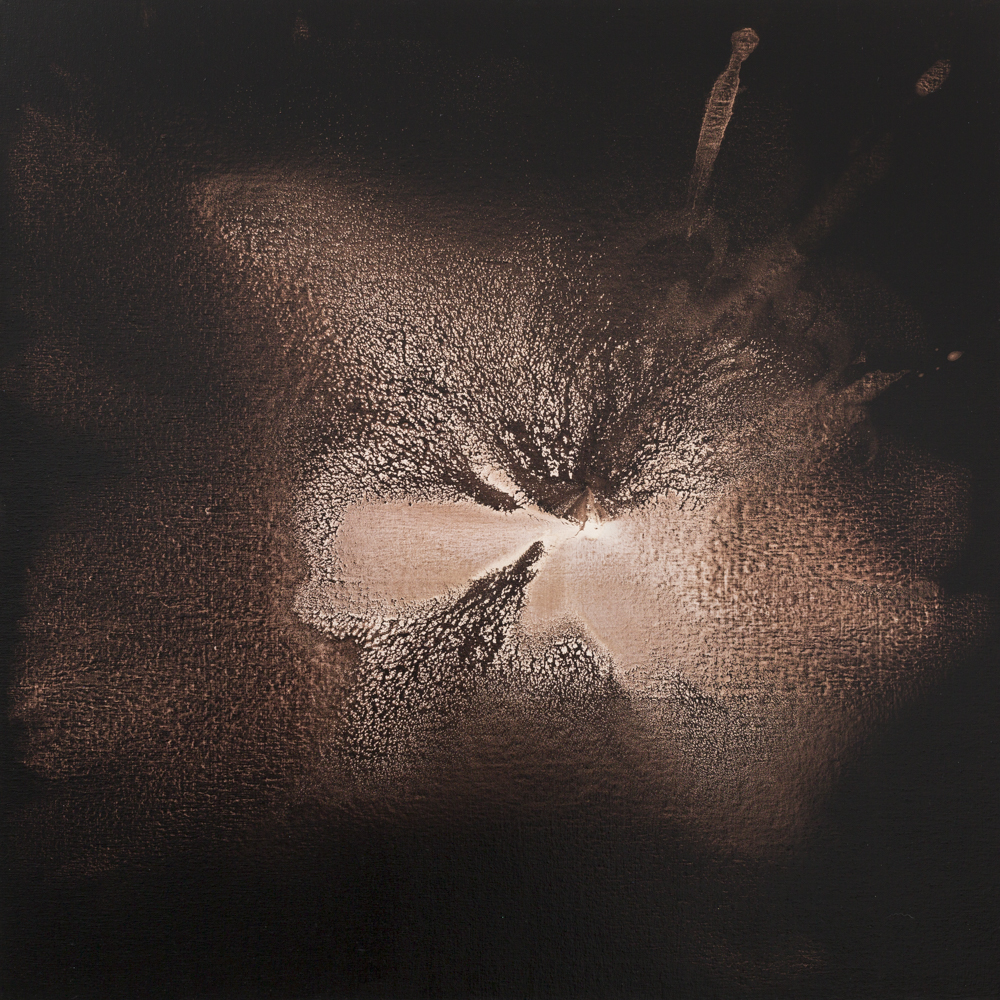
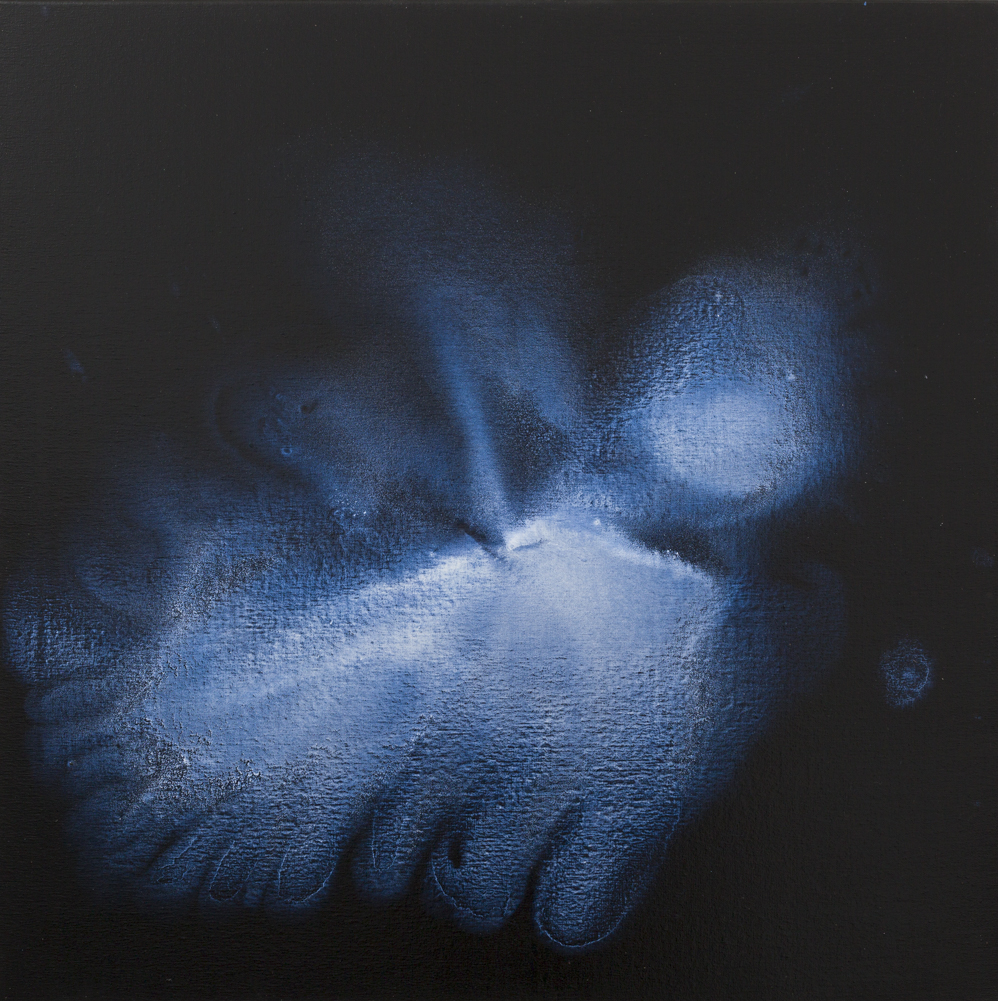
Prakash Patel
Metamorph (triptych) 2022
acrylic on canvas
Courtesy of the artist
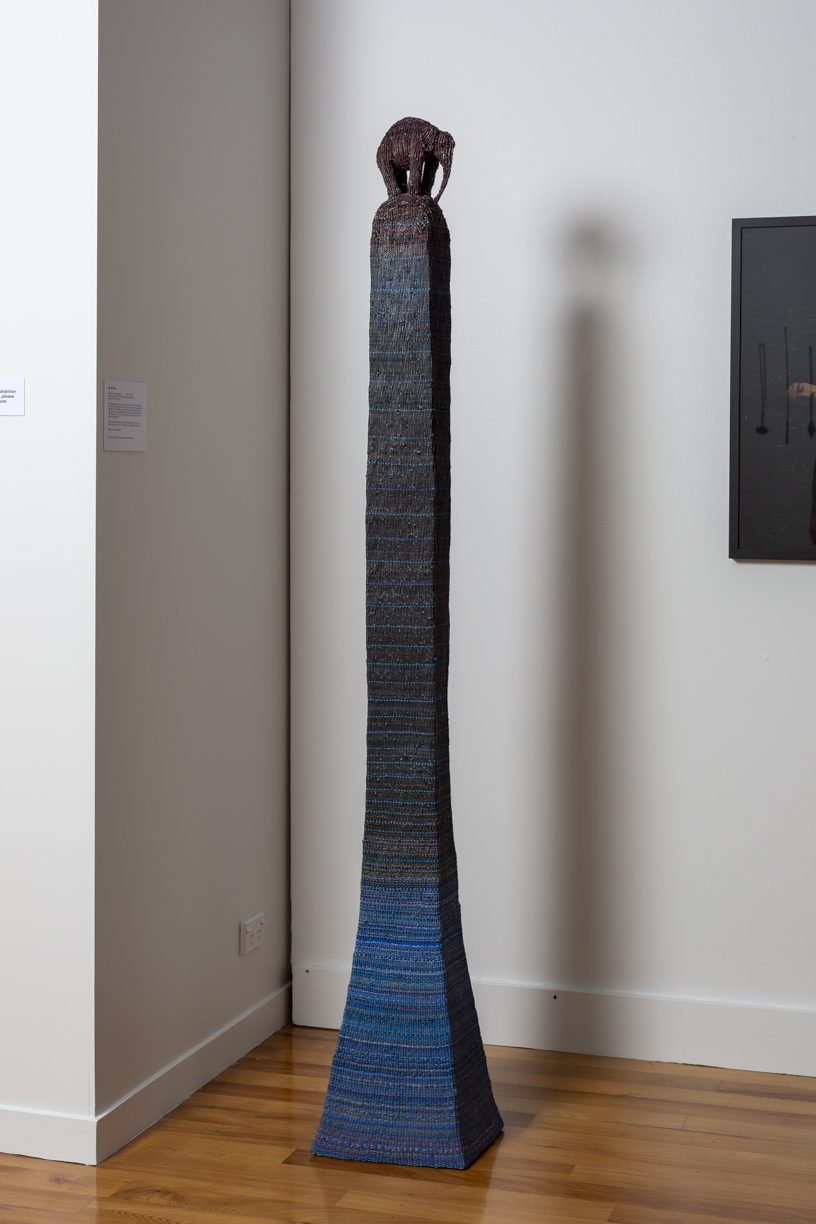
Penni Wyse
What is your elephant? 2015 – 2022
Automotive electrical wire, 18g galvanised wire
Courtesy of the artist
“Some years ago I watched a video about the artist ‘Banksy’. It
included footage of an exhibition opening which featured a live
elephant in the gallery. It occurred to me that each person in
the gallery crowd, sipping their drinks at a safe distance from
the ‘elephant in the room’, might be contemplating their own
personal ‘elephant’.
‘What is your elephant?’ is formally similar to ‘Harry Fat’, my
winning entry in the 2014 Whanganui Arts Review exhibition.
What is your elephant?”
Penni Wyse was the recipient of the2014 Bryce Smith & Associates Ltd Open Award
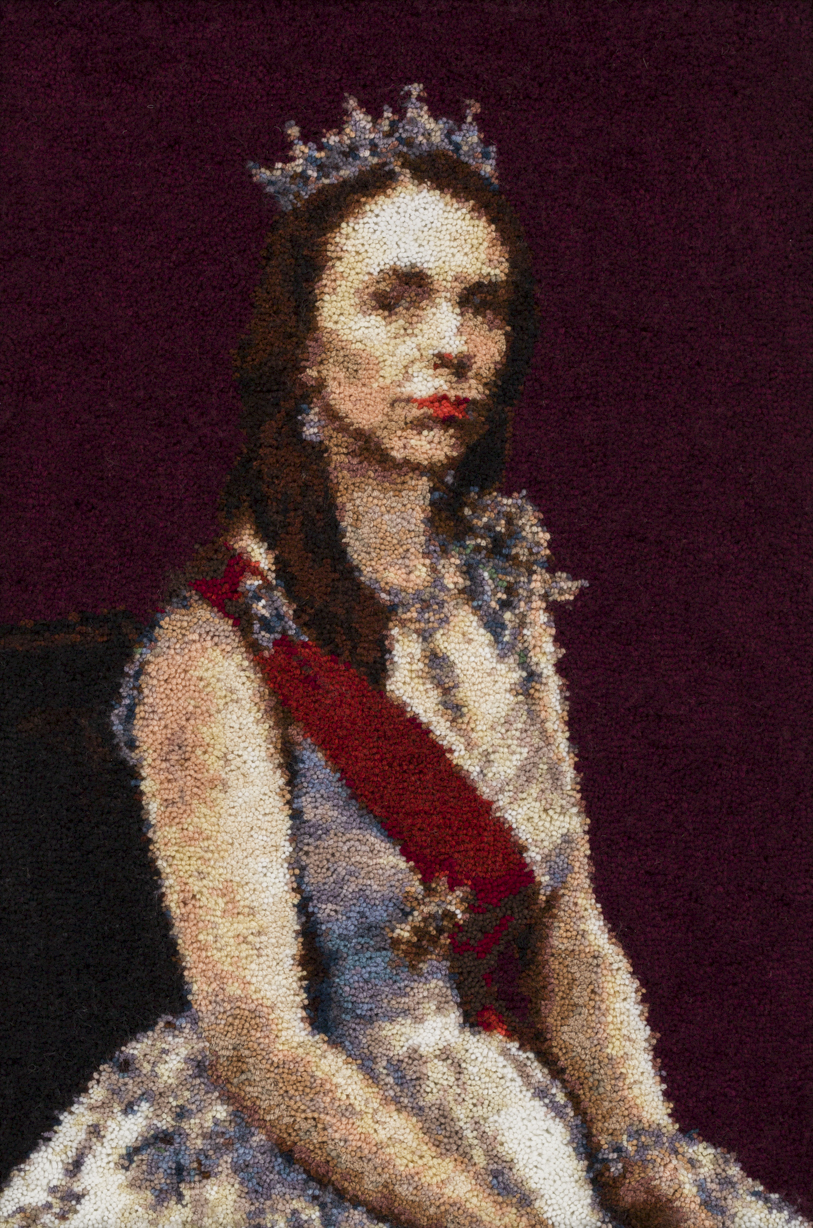
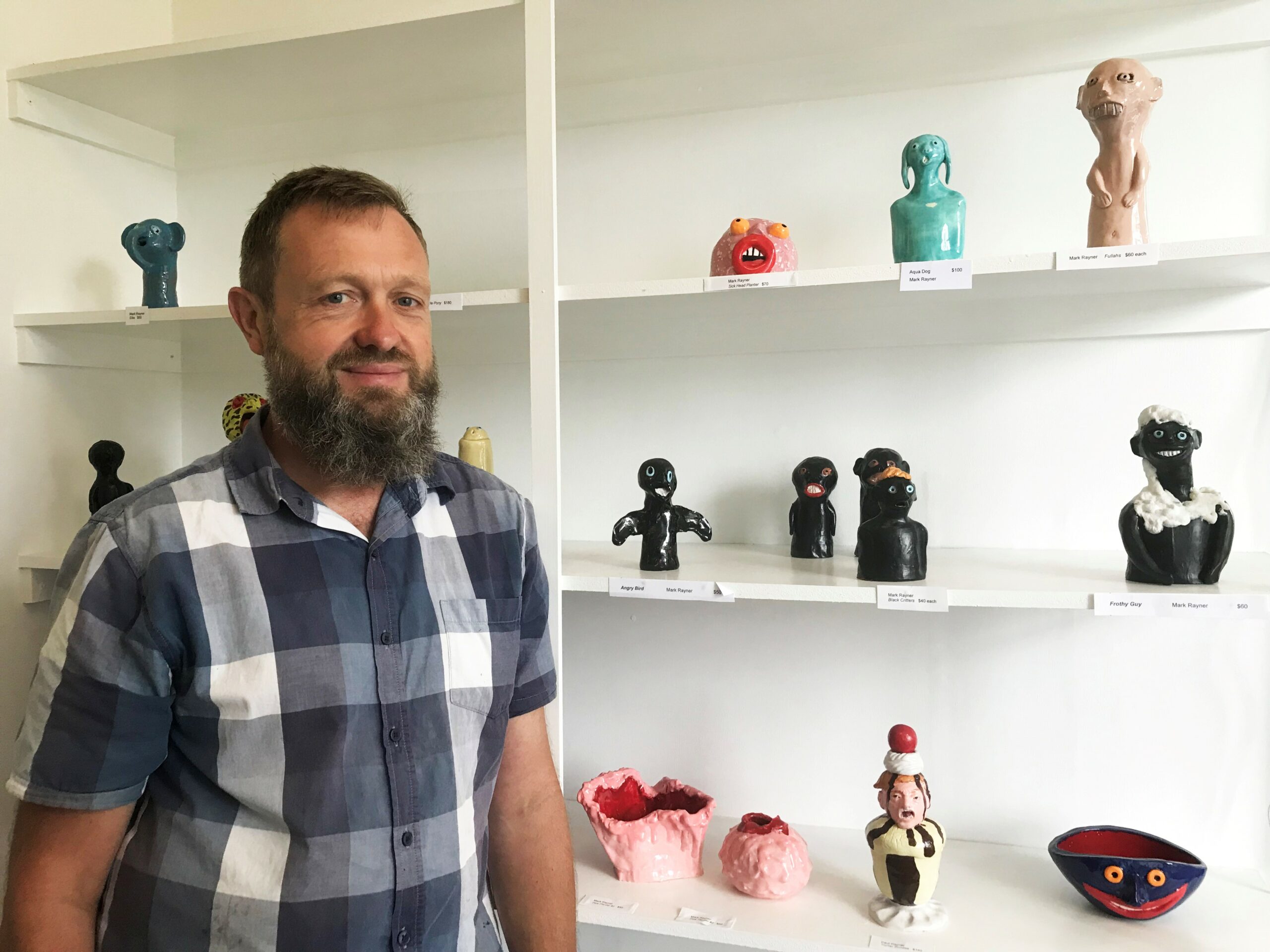
Mark Rayner
Mark Rayner
La Corona (The Crown) 2022
latch hook wool and rug canvas
Courtesy of the artist
“It was a great boost to win the Whanganui Arts Review award, and
since then I have created a number of latch hook rugs in tandem
with my regular ceramics practice. I find the two disciplines
complement each other nicely – the process of making a rug takes
many hours and is completed in a concentrated time frame with all
major decisions occurring before the work is even started so the
repetition of the making process is quite relaxed and meditative,
whereas my ceramic pieces are more spontaneous, evolving
quickly as they are made.
The portrait on show (made in January specifically for this
exhibition) fits well with a number of previous politically themed
rugs, which are usually inspired by recent current events or news
stories and created while the subject source is still topical. As with
these previous works, in creating the final digital image (in this
case an amalgamation of two existing photographic portraits taken
nearly 70 years apart) and then crafting this into a rug, I hope to
have created a certain ambiguity of intent. Ultimately, I am more
interested in any reaction or attitudes a work may generate in the
viewer than any ‘message’ or pre-conceived idea I might have.”
Mark Rayner was the recipient of the 2016 Belton, Smith & Associates Ltd Open Award
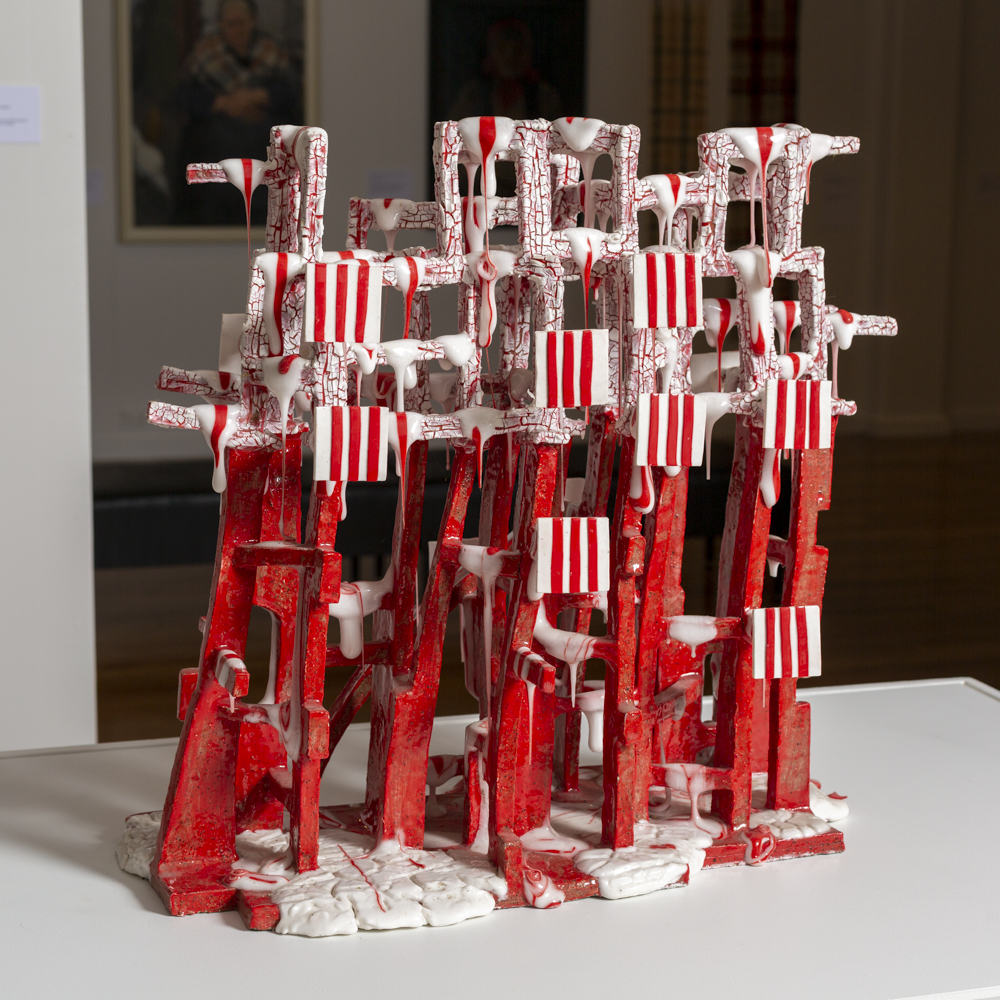
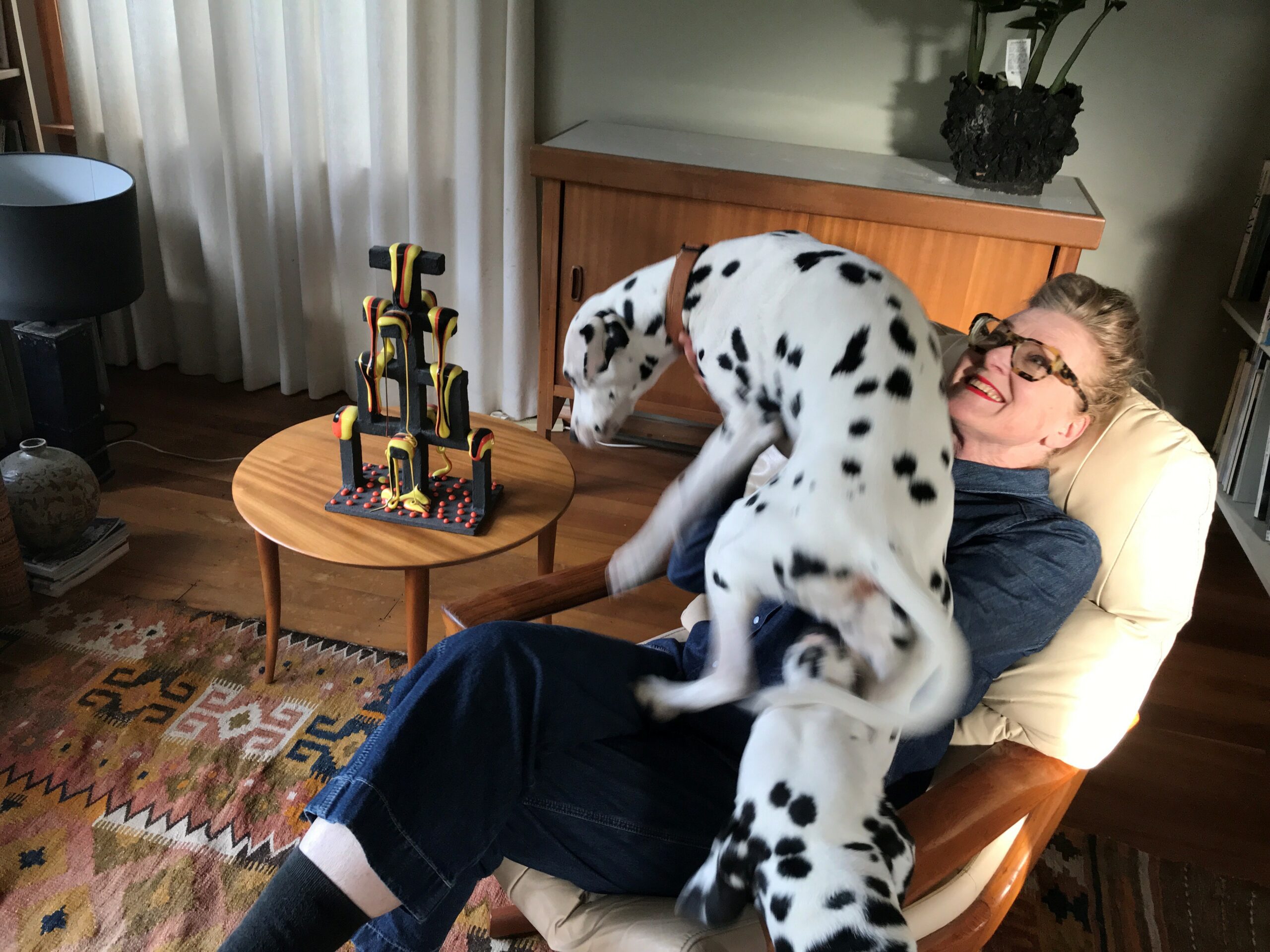
Andrea du Chatenier, picture by Anthony Davies
Andrea du Chatenier
Apple Tree 2019
ceramic
Courtesy of the artist
“The work which won the 2017 Open Award was the first of a series
of works which directly focused on the materiality of clay. The
work consisted of a stack of clay pieces stuck together with glaze;
I closed my eyes and put it in the kiln. The element of chance,
materiality and on-going experimentation drive my practice.
I measure the success of a work on its surprise factor when it
comes out of the kiln. I look at my process as being an alchemic
collaboration with clay and minerals – a type of magic geology.
Sometimes I like to take control and am tickled pink when the work
comes out exactly as planned but that’s a rarity. Carolyn Christov-Bakargiev made the comment that all good art should have a
degree of synesthesia or a perceptual “mucking with the senses”.
The ultimate level of success is when the viewer isn’t happy just to
look at the work but reaches out and licks it.
My current fixation is on metallic lustres which use oxides to form
glittering surfaces. The process is truly alchemic; it is finicky,
temperamental, and extremely difficult, but when its successful
it is dreamy. Mondrian painted an apple tree over and over again,
searching for a mystical sense of structure and balance to the
natural, spiritual and human worlds. Apple Tree seeks order, but its
structure is undone by its own material entropy; it warps, oozes,
cracks and curdles. Relating to geology as readily as human-built
structures, I value the vulnerability, precariousness, and state of
flux inherent in clay work.
The stillness experienced through Lockdown has some resonance
with geology: like it, we were fixed in one place experiencing new
rhythms of time, and transformation. Millions of years ago Earth
emerged from the stars as a collection of particles and became
part of a particular universe stuck in a fixed orbit. The life of clay is
one of constant response to its environment, played out at speeds
and scales very different to our own. In this moment of global
change there has never been a better moment to learn from the
materials of Earth.”
Andrea du Chatenier was the recipient of the 2017 Belton, Smith & Associates Ltd Open Award and also the 2013 Members of the Sarjeant Gallery Highly Commended Award
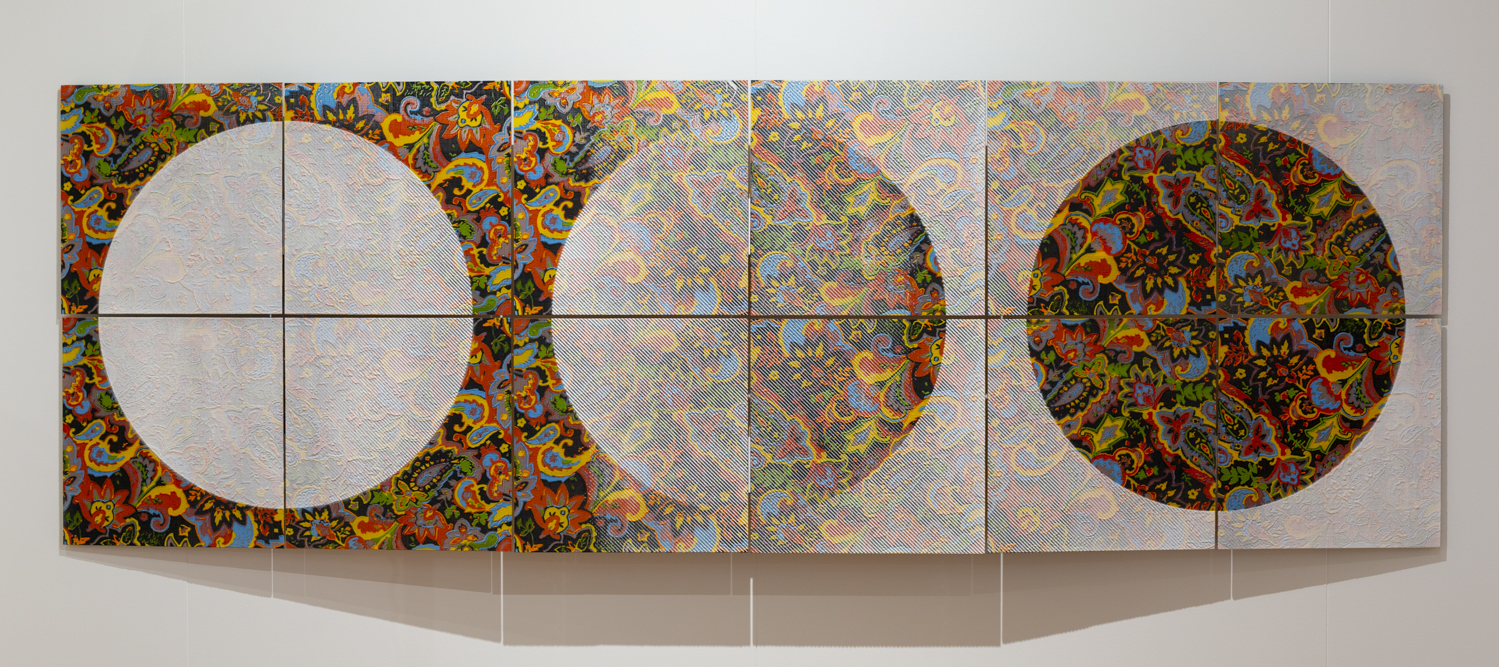
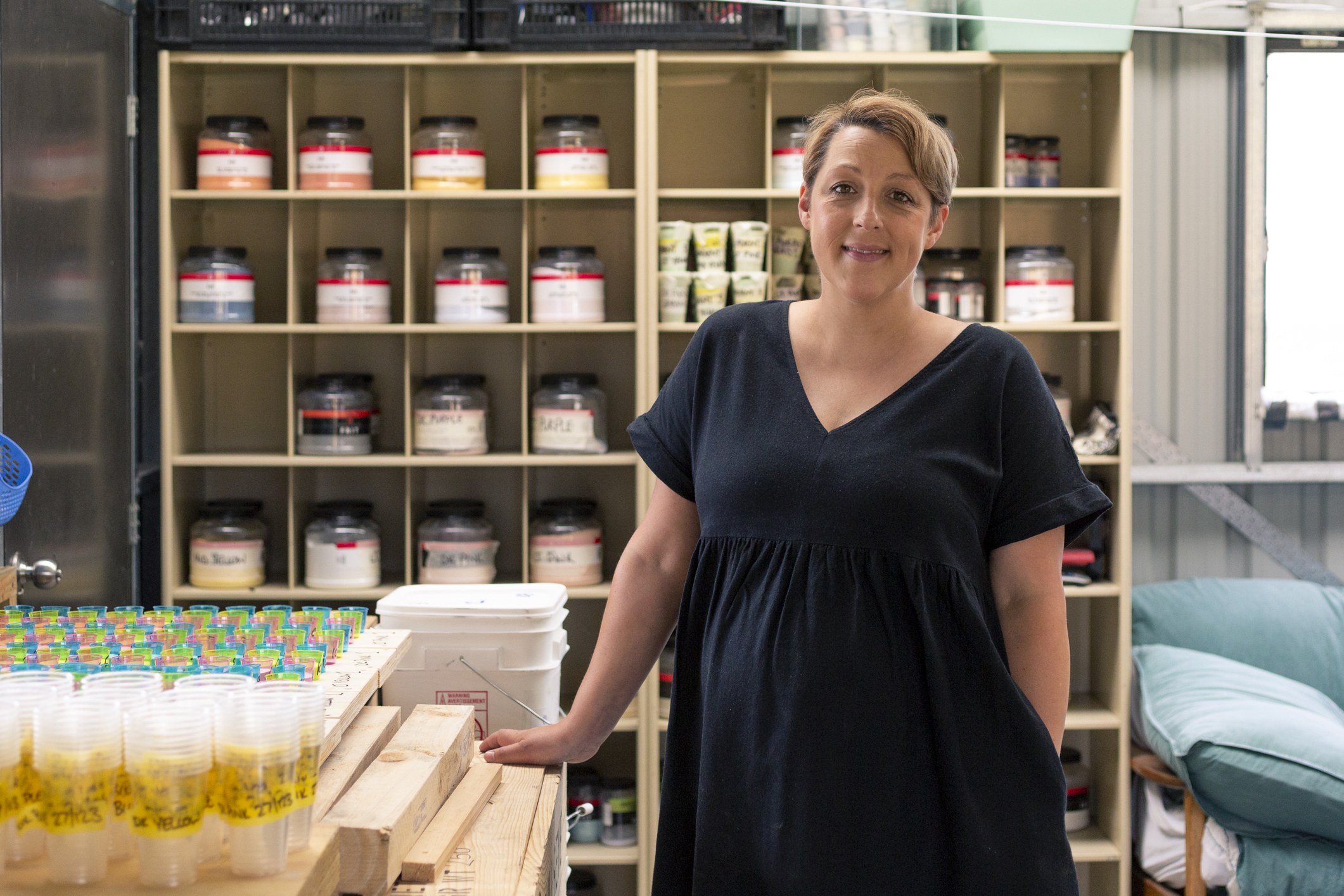
Dr Kathryn Wightman
Kathryn Wightman
In-Between 2022
sifted and sintered glass powder on sheet
Courtesy of the artist
“The award has allowed me to consider the impact of scale and to
take steps towards creating more immersive spaces for the viewer.
I have also been able to further explore additional technologies
alongside glass including 3D scanning and 3D printing.
My current practice is centred around the exploration and
representation of human behaviour whether that be through
the eyes of a mother and or as a member of society. Perception,
memory, and emotion are key aspects that inform the work
alongside the use of pattern and colour. In my work, the decorative
becomes the vehicle for expression.
This work builds on previous glassworks that utilise the sifting
and sintering process I have developed. However, in this triptych,
layering through the use of halftone gradients has been used to
alter what can and can’t be seen by the viewer. The work prompts
us to consider the contrast between things as well as what might
exist in the space in-between. An emptiness full of possibility.
Art has the ability to humanise us, to create new ways of seeing
and communicating in a time when there is so much uncertainty
and struggle.”
Dr Kathryn Wightman was the recipient of the 2013 Central City Pharmacy Highly Commended Award, also the 2018 Sarjeant Gallery Te Whare o Rehua Whanganui Open Award and the 2019 Pattillo Whanganui Arts Review Open Award
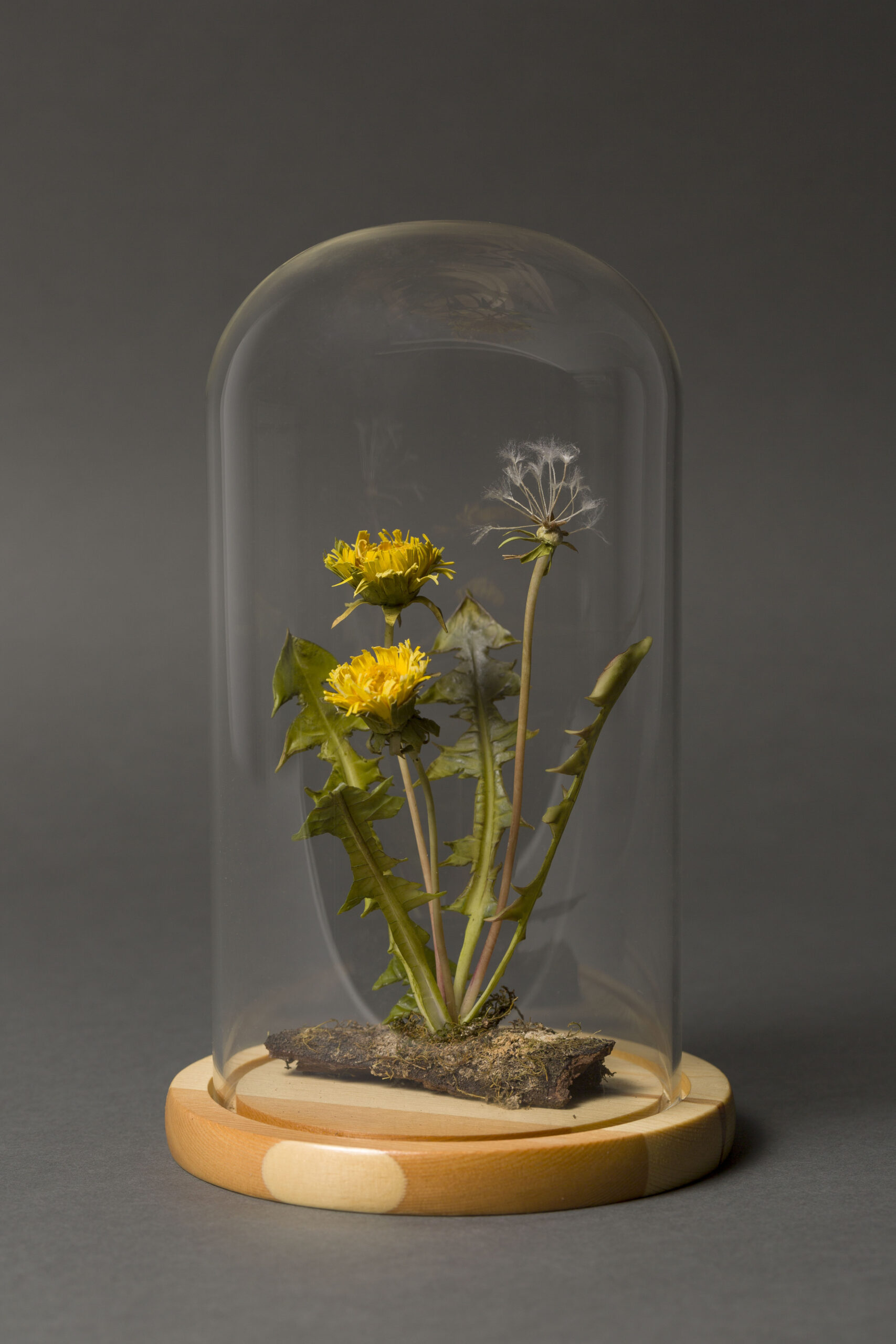
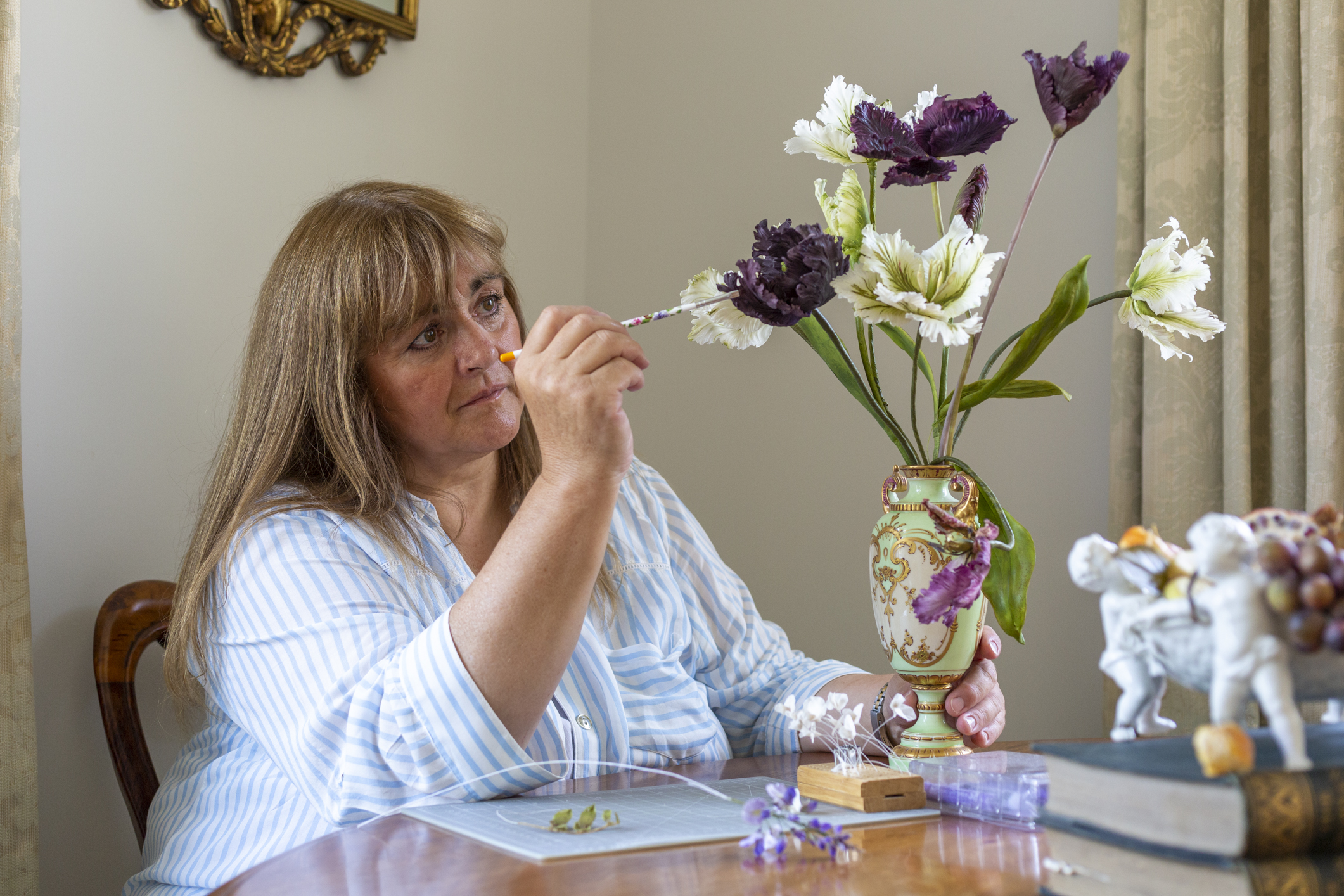
Tracy Byatt
Tracy Byatt
Beauty or Beast? 2021
sugar
Courtesy of private lender
“Artists have the freedom to represent a plant as they choose,
while a botanical artist wants to represent a plant with scientific
accuracy. It’s a fine line.
Sculpting a standalone piece, no matter how large or small, takes
a long time. There are always many things to consider with every
plant but the process of research and learning beforehand is
so much more than the visual sum of its parts. Recording with
preliminary graphite sketches and small watercolour studies is an
integral part of my research and interests me more and more.
Many of the specimens I observe will never make it to finished
sculptures due to time constraints but they all contribute to my
understanding of plants as a whole and my approach to recreating
them.
I find it particularly intriguing how any plant is valued and how that
changes historically. Common plants really are just as fascinating
as rare ones. The poor dandelion has had a lot of bad press in the
past and is still vilified in agriculture. Today, however, it has gained
a lot more respect for providing food for pollinators and is praised
for its medicinal benefits. I suppose it is all about balance.
My garden has its fair share of dandelions but, having become so
well acquainted, I rather like them – and so do the bumblebees!”
Tracy Byatt was the recipient of the 2020 Pattillo Whanganui Arts Review Open Award
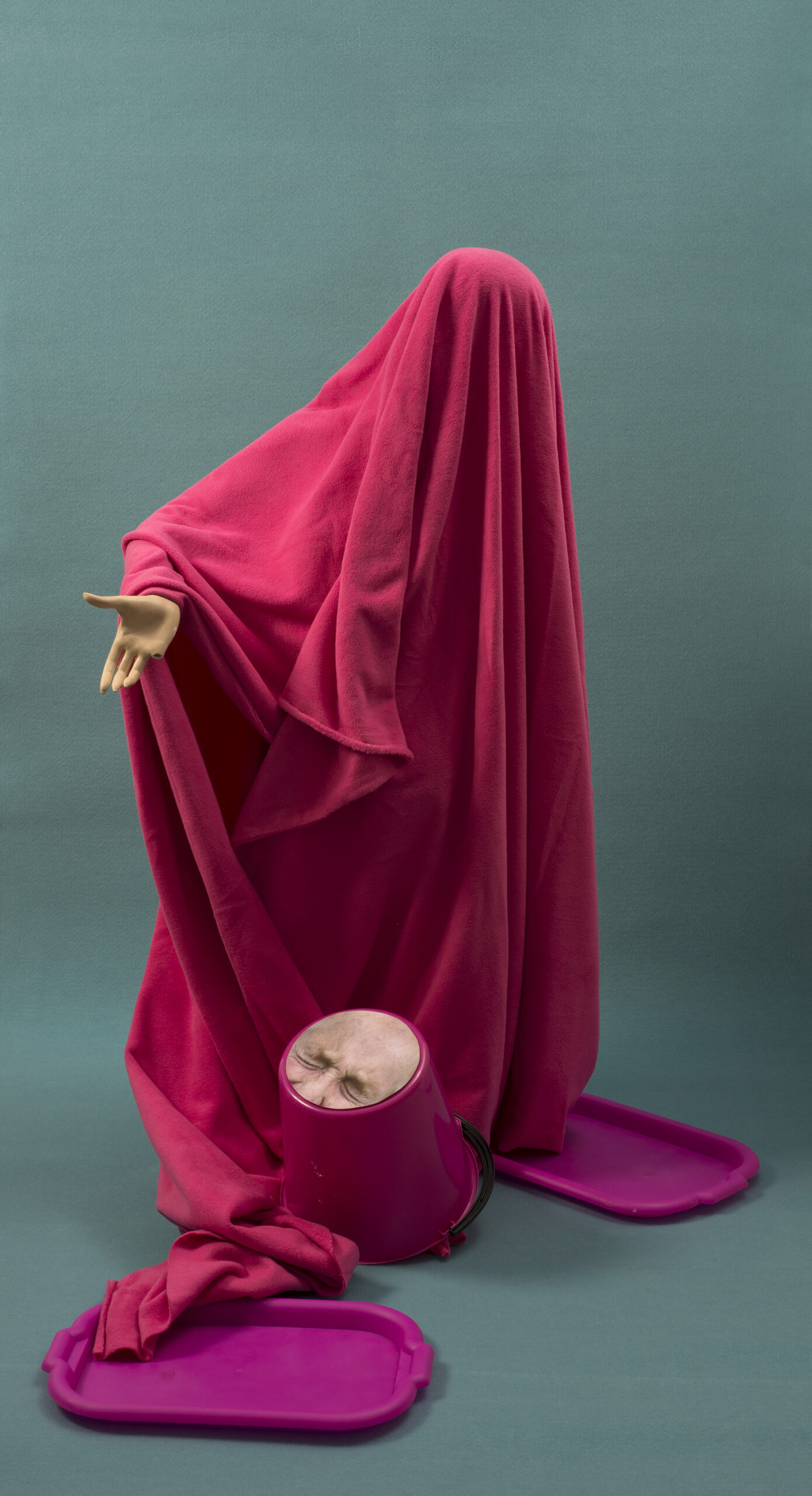
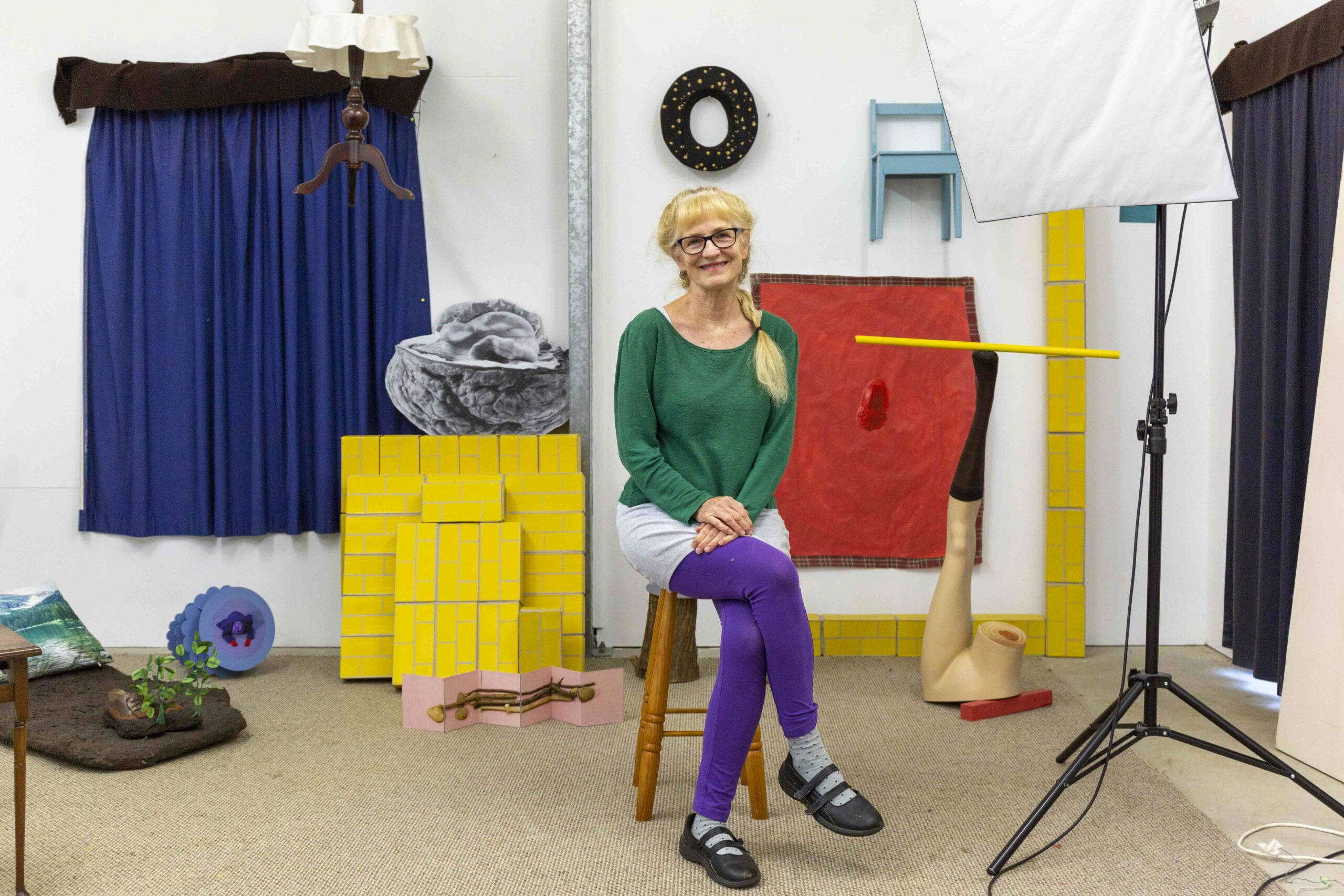
Andrea Gardner in her studio. Photo by Michael McKeagg
Andrea Gardner
Eyes Tight Shut 2020
photograph on Hahnemühle Ultrasmooth paper mounted on Dibond
Courtesy of the artist
“Eyes Tight Shut is part of a series I took using coloured plastic
buckets and photographs of my face which I glued onto the
bottom of the buckets. I do staged photography in the studio
where I can make set-ups, control the lighting and experiment with
colour. Sometimes I am in the images or, in this case, my presence
is there in the photo on the bucket. It is interesting to think about
what happens when we shut our eyes tightly. I came across this
quote from the Persian poet Rumi: “Close your eyes, fall in love,
stay there.”
Andrea Gardner was the recipient of the 2021 Pattillo Whanganui Arts Review Open Award
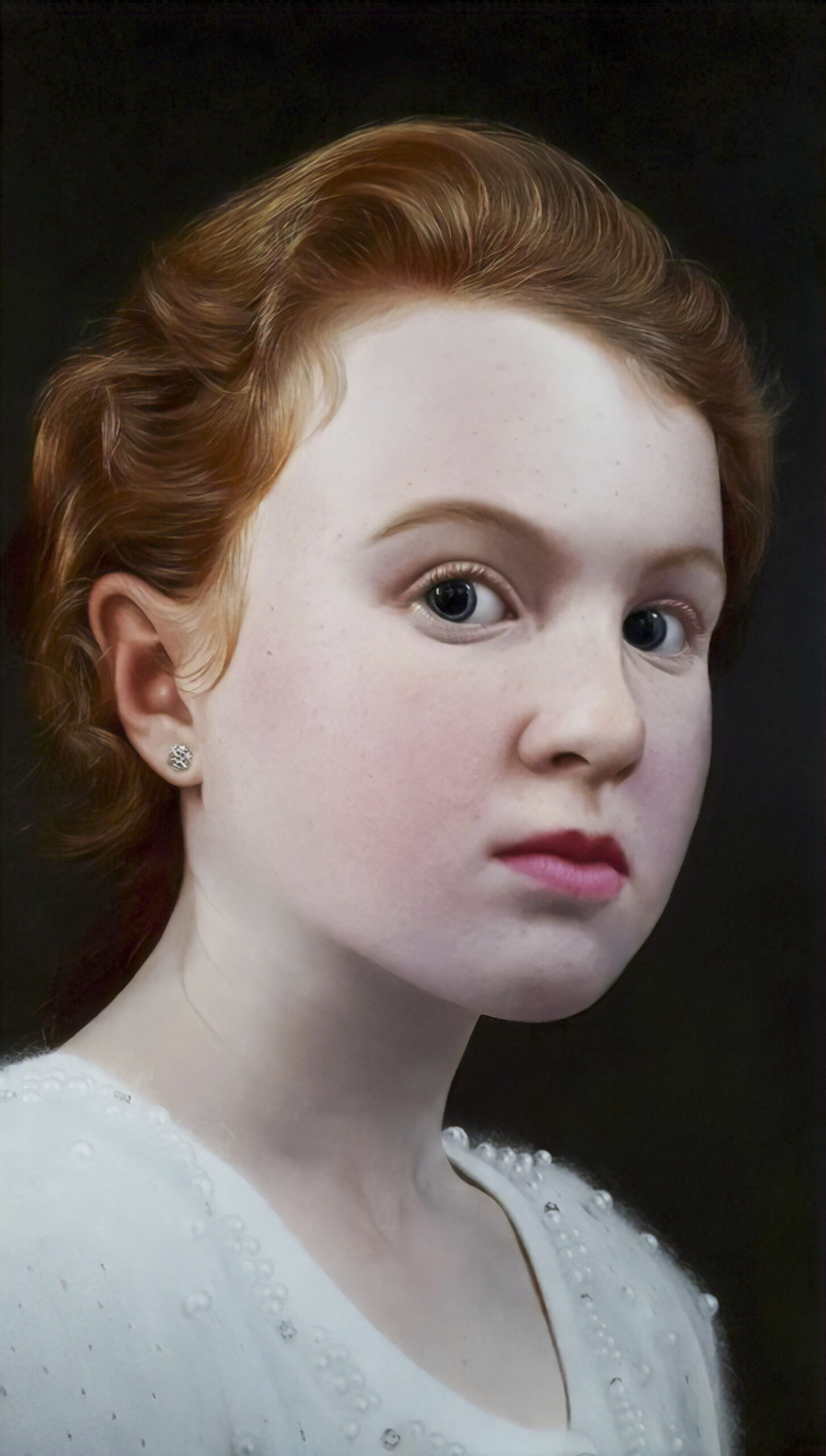
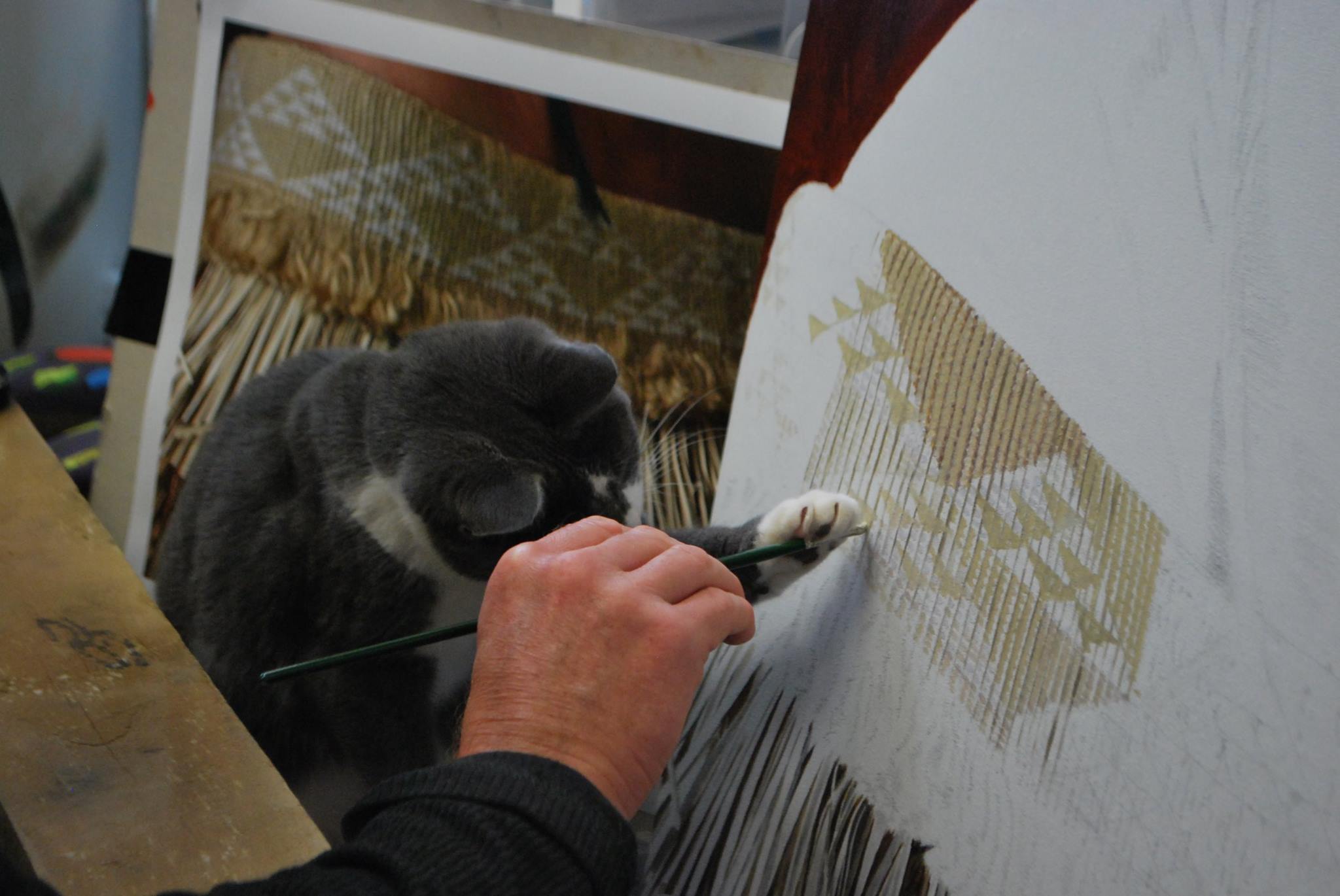
André Brönnimann and friend in the studio
André Brönnimann
Danielle 2017
oil on linen
Courtesy of the artist
“Since the award I have continued to focus on portraits and have
started a series with the models being in a water setting, out from
the studio into nature. This is what I am currently working on, but
will possibly change back to painting surreal works for a while. I
have a backlog of ideas and the excitement is there to put them
onto canvas.
My wife spotted Danielle with her family at a random festival, and
we were amazed at her looks and personality. Her expression and
poise belies the fact that she was just nine years old. She didn’t fit
into my artistic practice at the time, but I had to do it. She is one of
my favourite works.
I believe that in our current covid environment the role of the
visual arts has gained in importance. To quote Friedrich Nietzsche:
“We have art, so we shall not die of reality”. Reality got a bit
grimmer, so anyone that finds solace in art had something to
connect with.”
André Brönnimann was the recipient of the 2011 Carey Smith & Co Ltd Highly Commended Award.
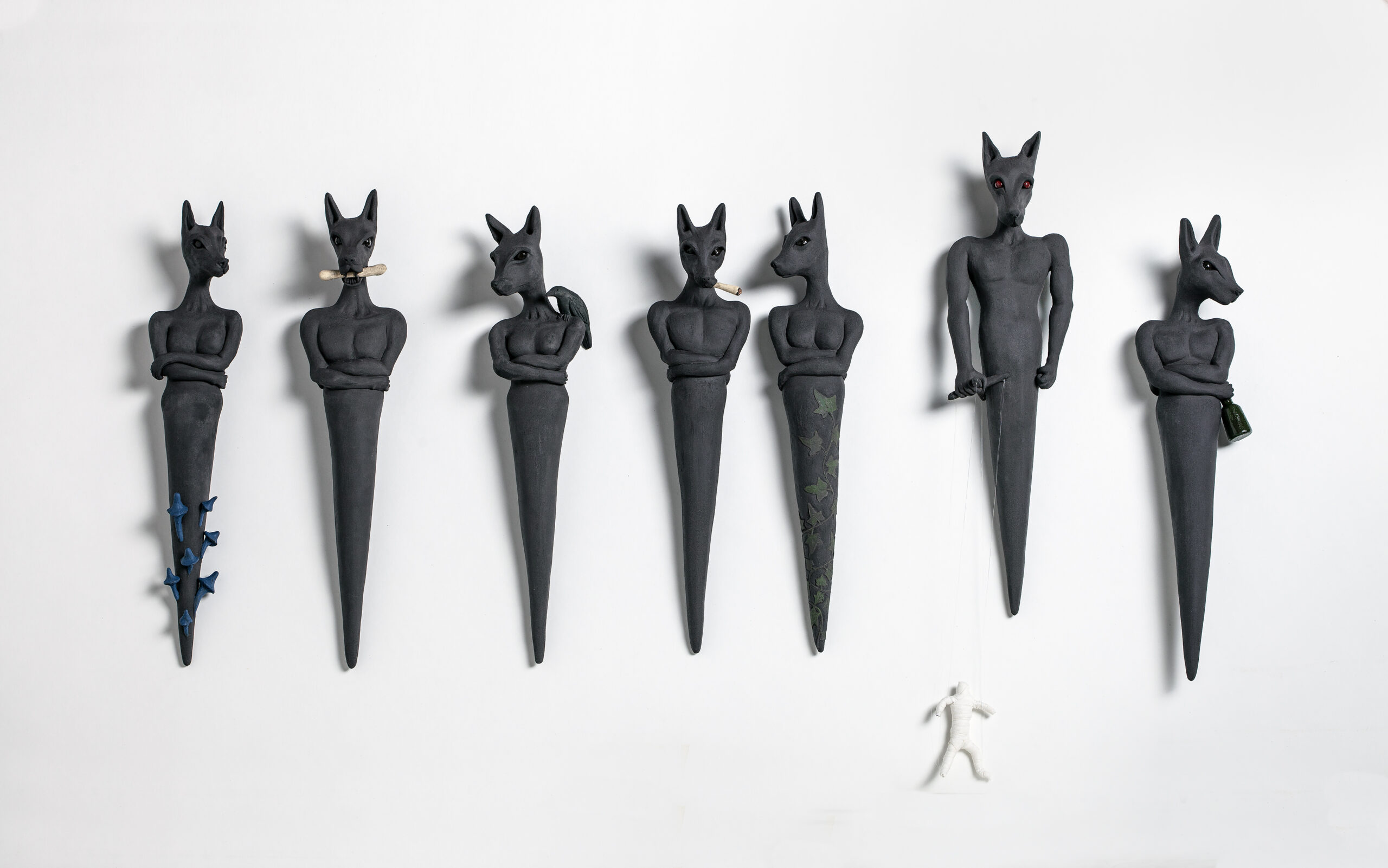
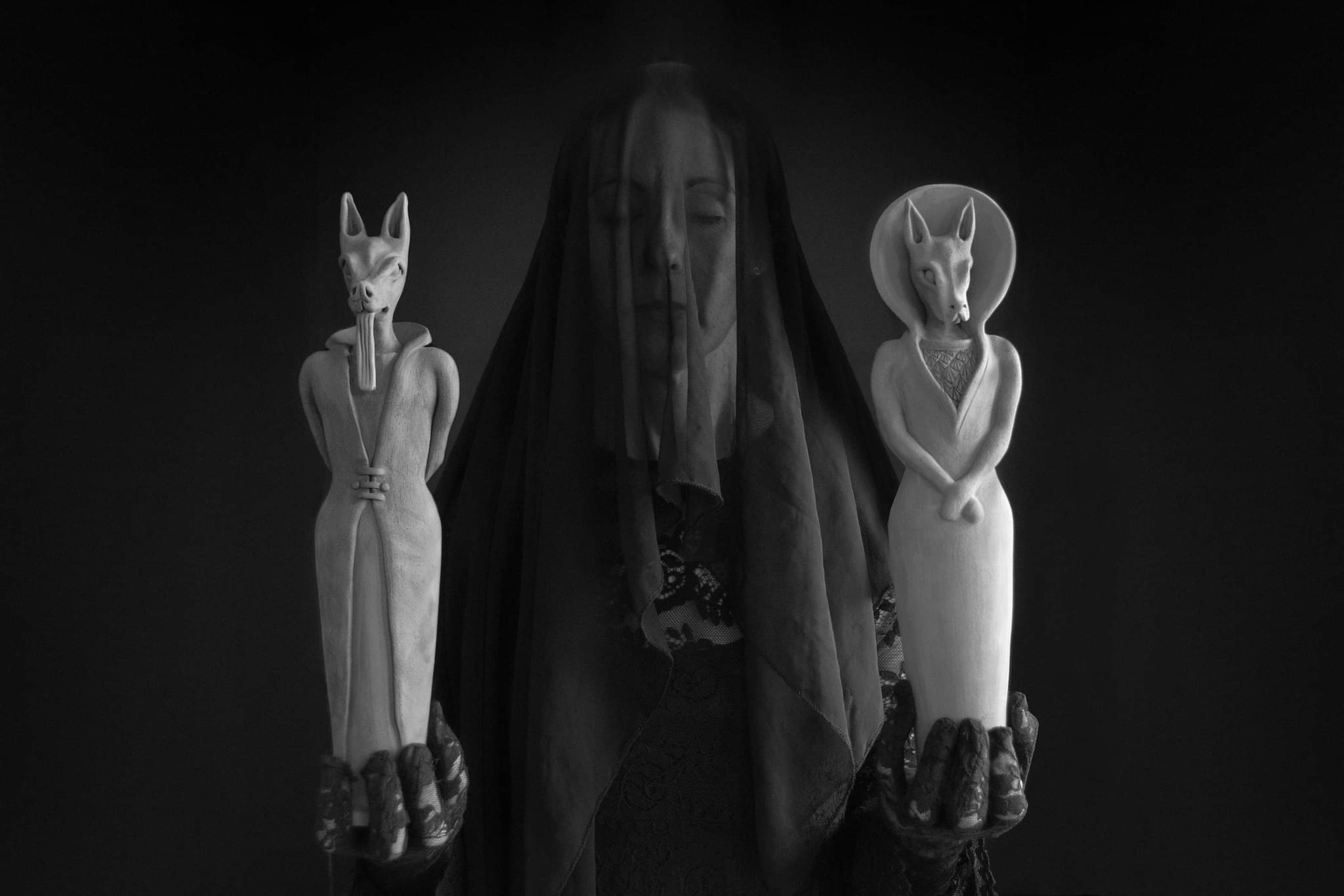
Angela Tier
Angela Tier
Jinn Dog (series of 7) 2021
left to right:
Blue Meanie, Bone Mad, Dark Spirit, Toker, Entanglement, Manipulation,
Intoxication
Each is black stoneware
Courtesy of the artist
“Over the past decade my art practice has changed; from predominantly
photography to creating with clay. This change happened after the
2015 Whanganui River flood. I had a photography studio on Taupō Quay
where most of my gear was lost. I remember standing there and just
looking at all the mud; this was the moment when I began transitioning
over to working with clay.
The focus of my ceramics practice has been about relationships and
vulnerability; the imbalance between man and nature, our impact on
animal species, the role science plays in the reanimation of nature
and the consequences of humanity’s biased choices contributing
to environmental changes. On a Wing and a Prayer (2017) was a
collection of bird shaped urns that focused on New Zealand’s critically
endangered birds and our responsibility to save them. Gone Bird (2017)
was a series of urns representing a selection of extinct native birds that
we had already lost and Pest Control (2020) explored the introduction
of foreign animals to New Zealand and how this contributed to loss
of native flora and fauna. The three Ibis bird figures that featured in
Ten (2020), a group exhibition at Zimmerman Gallery, contemplated
de-extinction of the iconic Huia and the current efforts to bring back
extinct species through questionable scientific studies. Recently,
the exhibition Bittersweet Wish: The Flight of the Genie Birds (2021)
reflected on the introduction of foreign birds to New Zealand having
undesirable outcomes for native species and agricultural production.
The Jinn Dog series are seven haunting dogs that float like dark-minded
Jinn, each appearing with offerings. This is a sharp turn inwards and
reflects the transformation of our everyday lives through unexpected
changes. These new works were made during times of forced isolation,
debates about mandates and the heavy clouds of uncertainty looming
over the future. Black clay seemed fitting for these dark days. The
deceitful dogs appear with questionable remedies and coping
mechanisms, a way of escapism or distraction from harsh realities of
the present. Creating with black clay in the current covid environment
feels to me like wearing appropriate mourning clothes.
If you are interested in finding out more about my art projects, please
visit angelatierart.nz“
Angela Tier was the recipient of the 2011 Carey Smith & Co Ltd Highly Commended Award
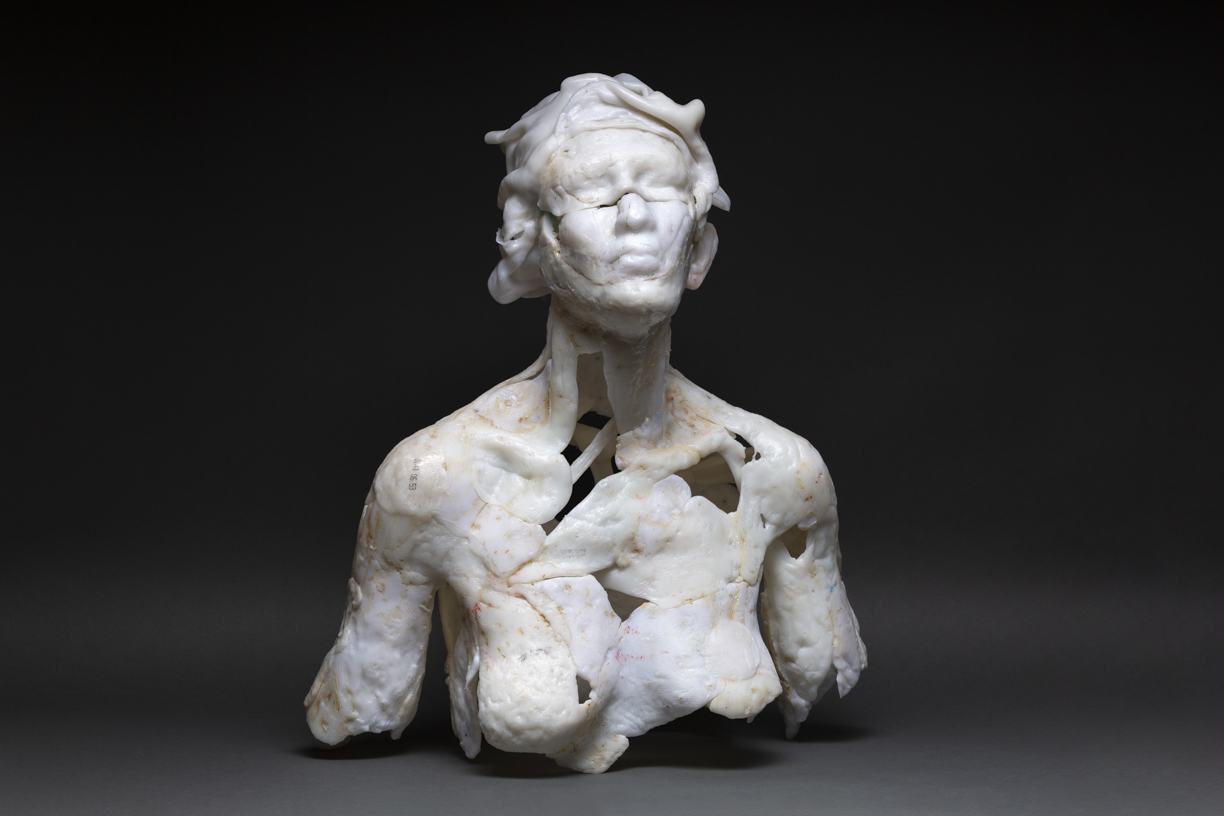
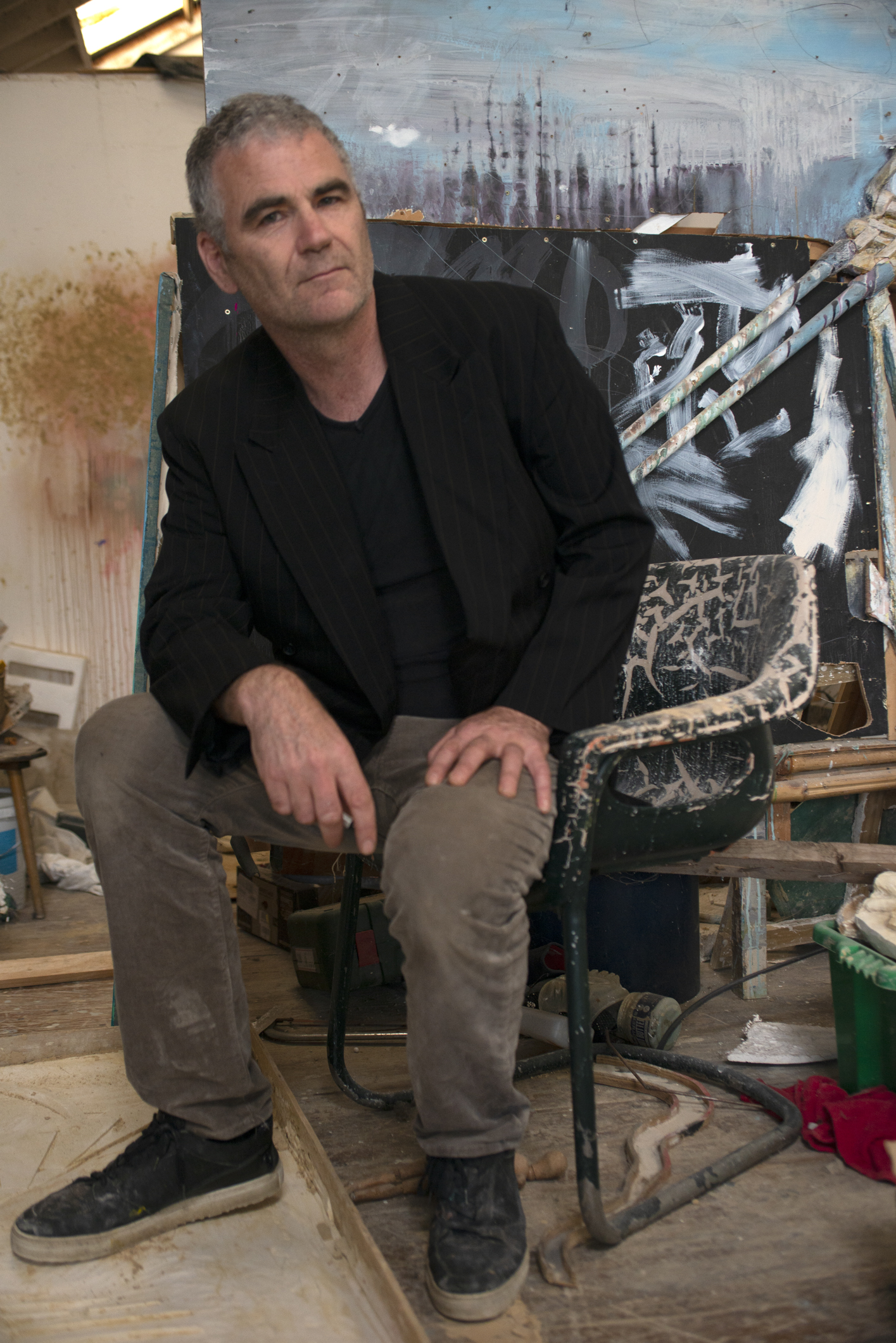
Kirk Nicholls in his Whanganui studio. Photo by Johnny Gembitsky.
Kirk Nicholls
Untitled 2022
recycled milk bottles
Courtesy of the artist
Kirk Nicholls was the recipient of the 2011 Carey Smith & Co Ltd Highly Commended Award
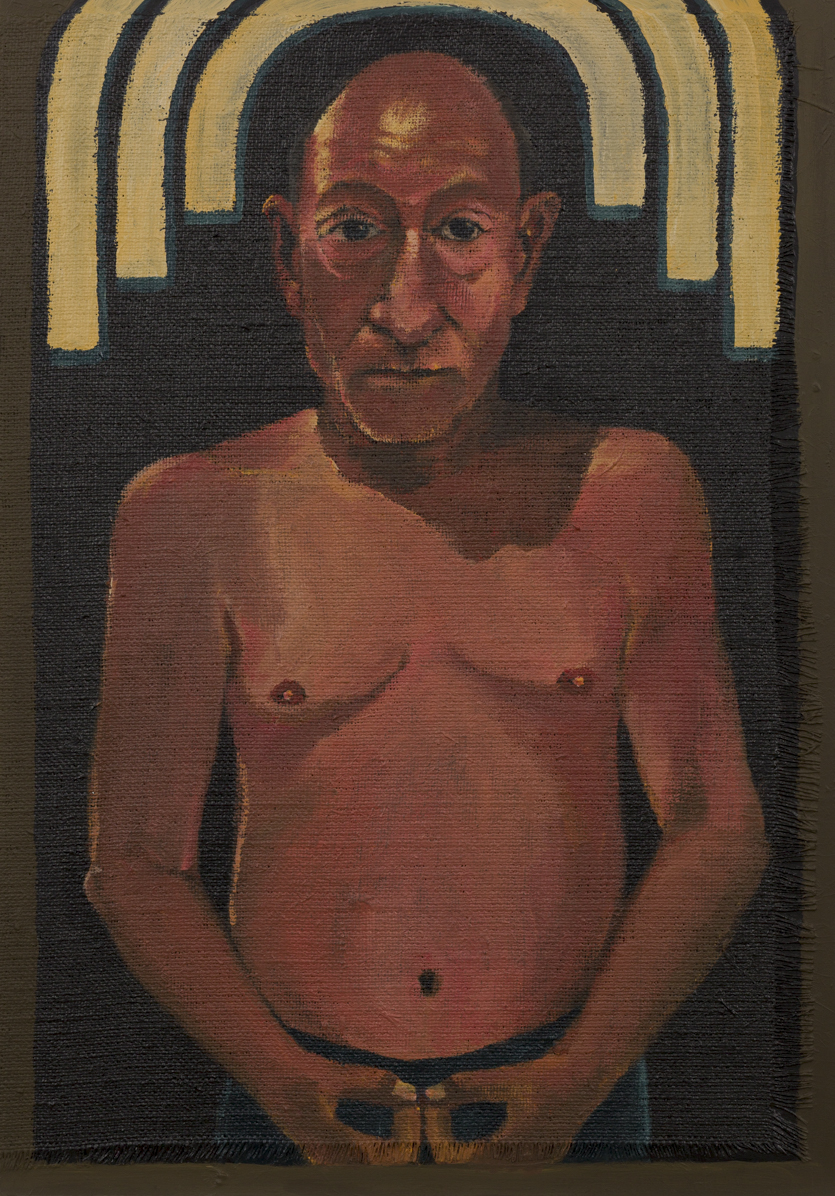
Paul Rayner
Self Portrait (after John Kane) 2022
acrylic on hessian
Courtesy of the artist
Paul Rayner was the recipient of 2014 Bryce Smith & Associates Ltd Highly Commended Award
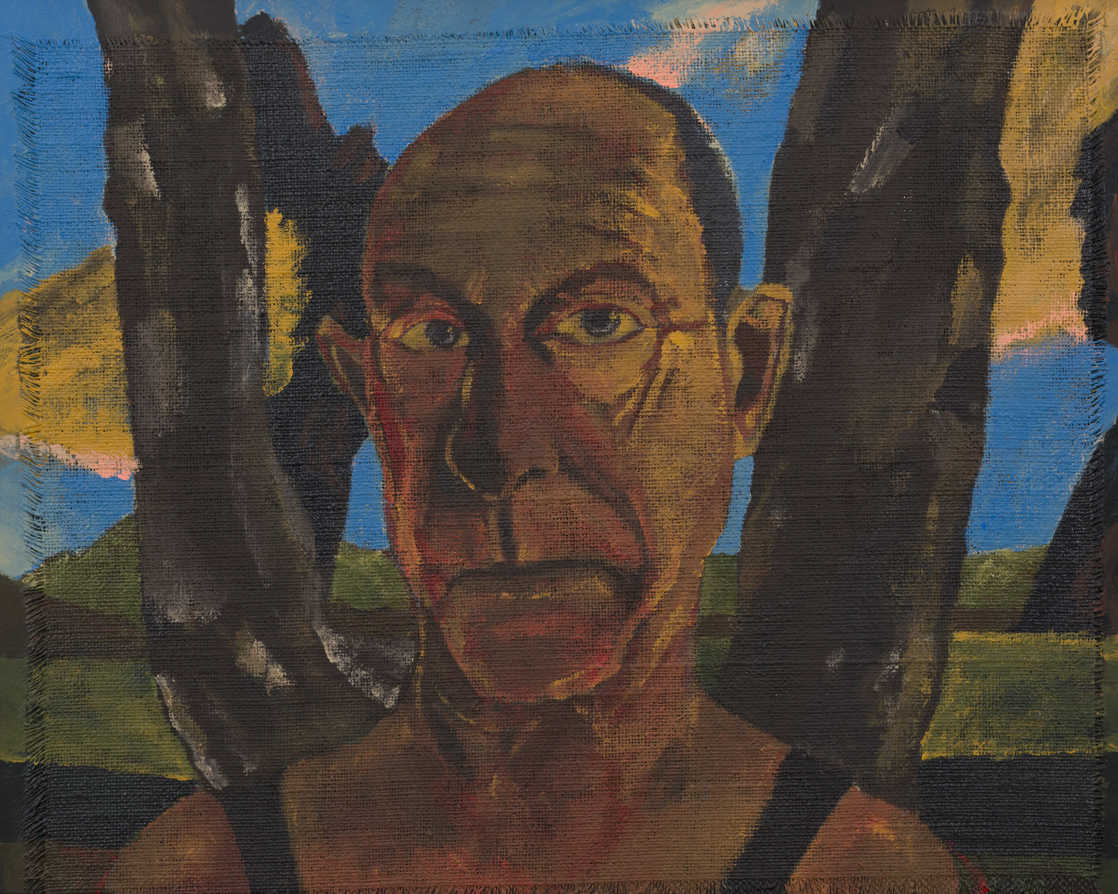
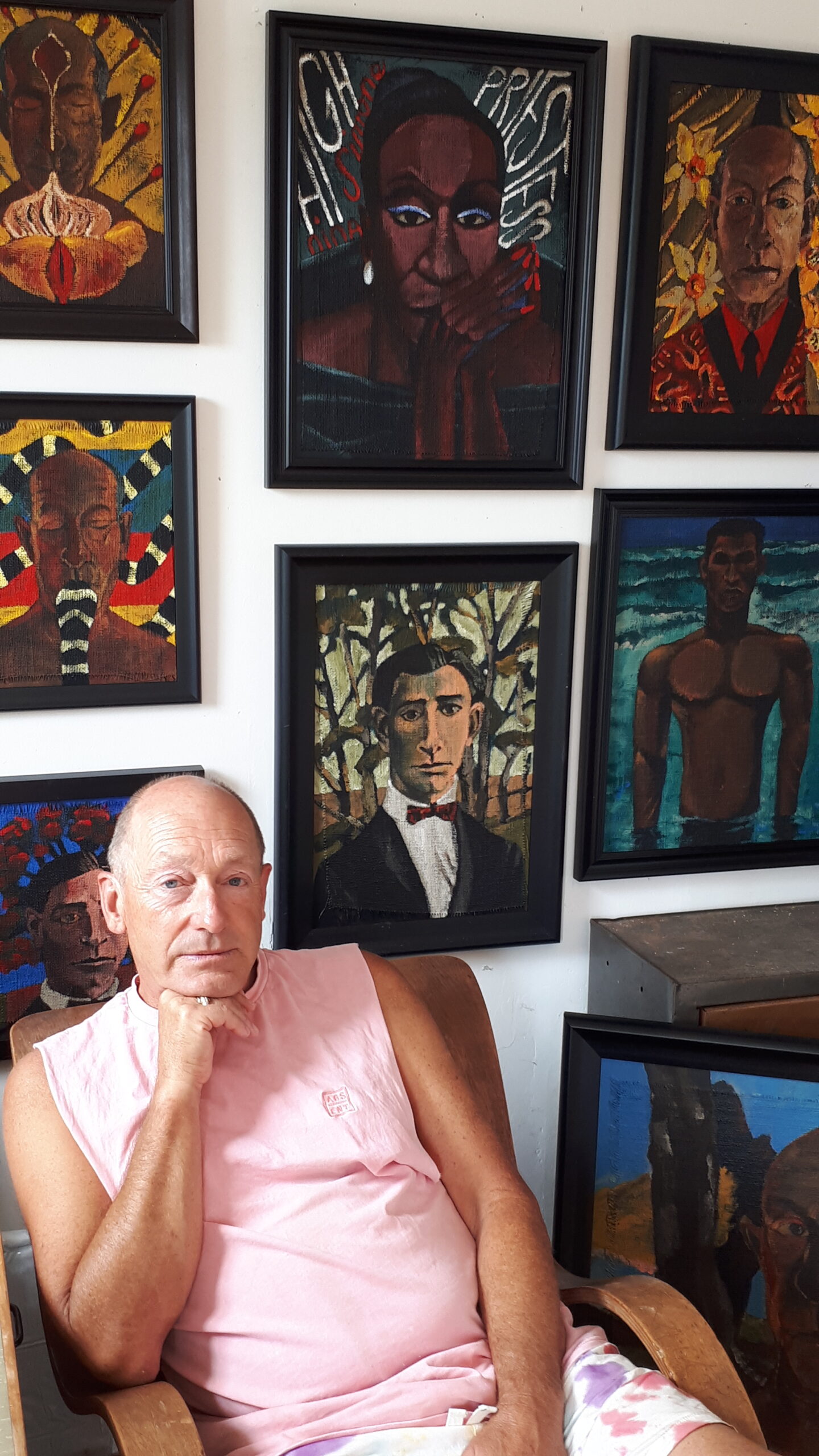
Paul Rayner in his studio. Photo by Mark Rayner.
Paul Rayner
Self Portrait at Bason Botanical Gardens 2021
acrylic on hessian
Courtesy of the artist
Paul Rayner was the recipient of 2014 Bryce Smith & Associates Ltd Highly Commended Award
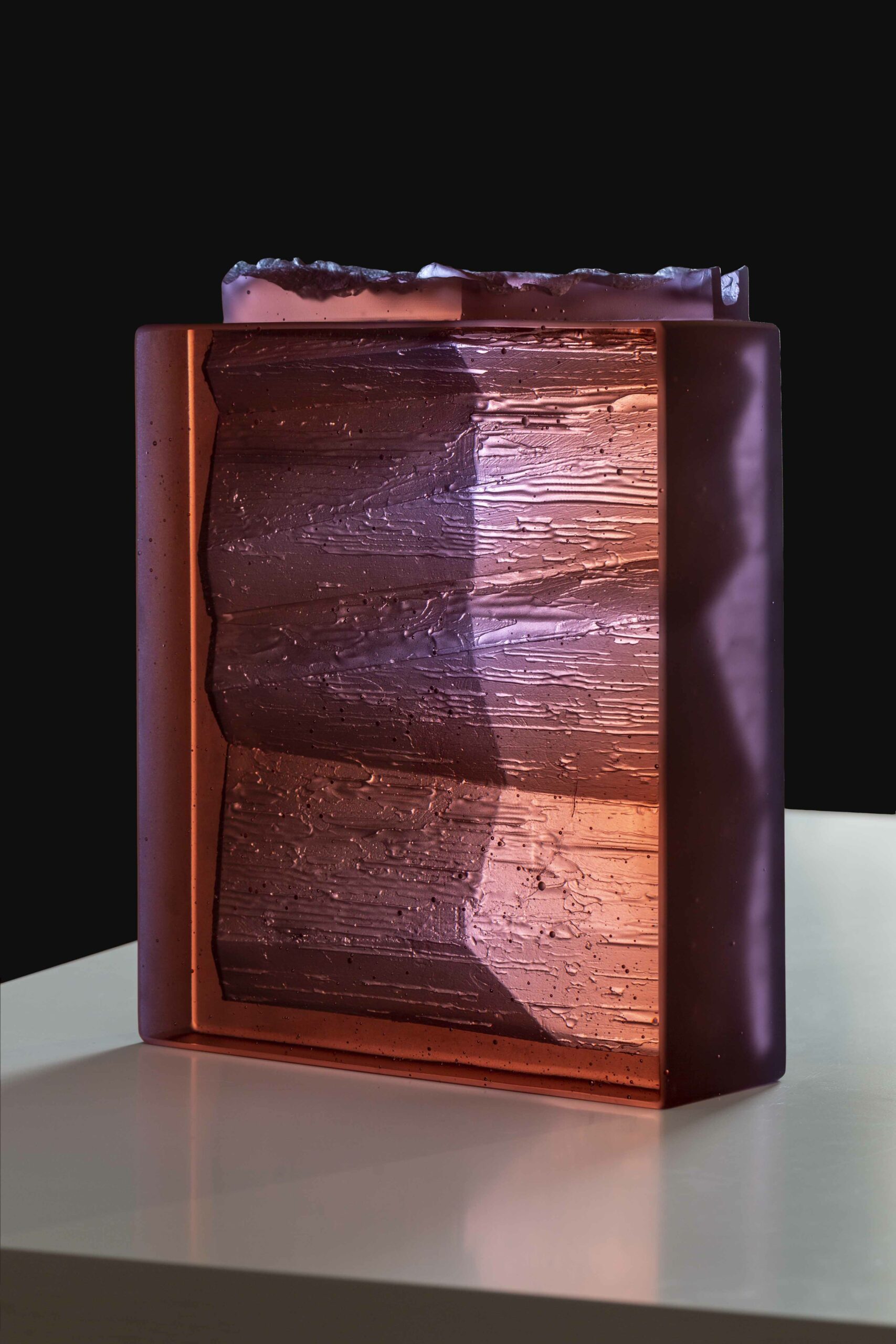
David Murray
Territory (Sapphire Rose) 2022
cast glass
Courtesy of the artist
David Murray was the recipient of the 2016 Belton, Smith & Associates Ltd Highly Commended Award
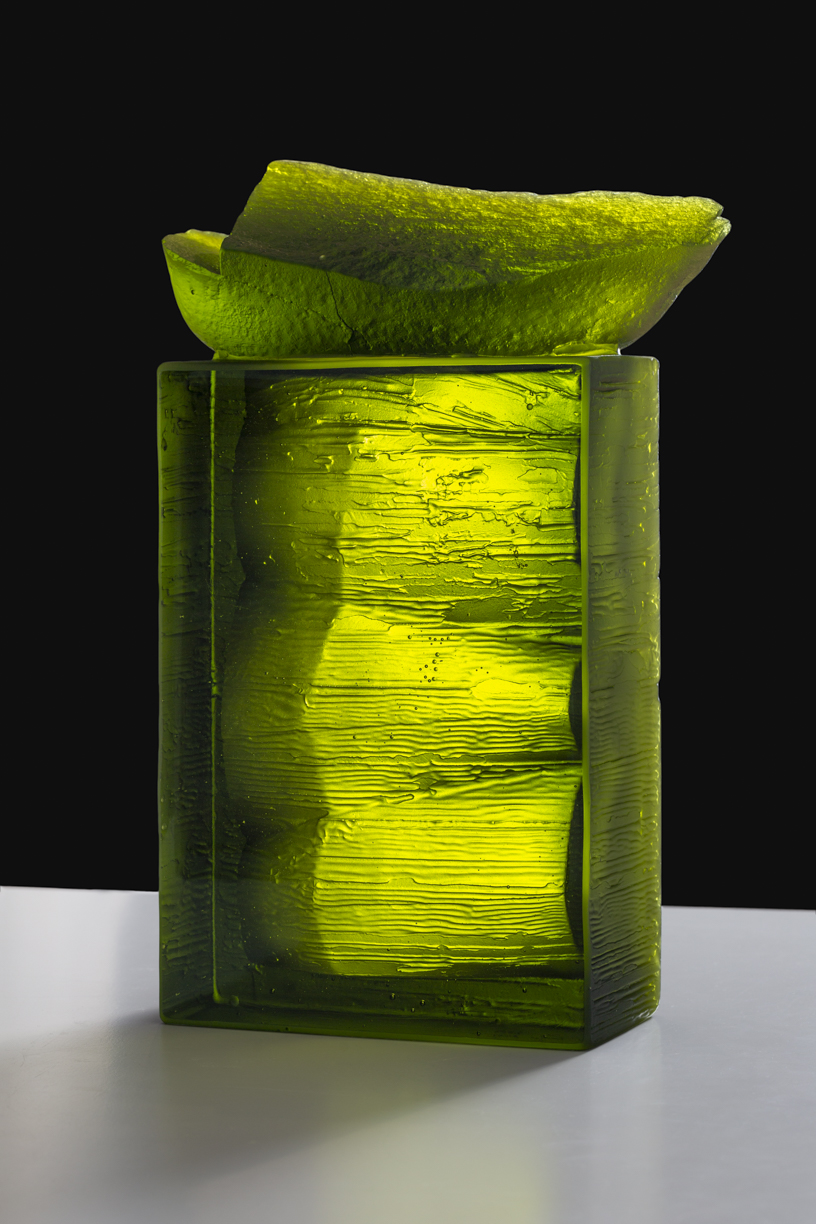
David Murray
Territory (Olive Green) 2022
cast glass
Courtesy of the artist
David Murray was the recipient of the 2016 Belton, Smith & Associates Ltd Highly Commended Award
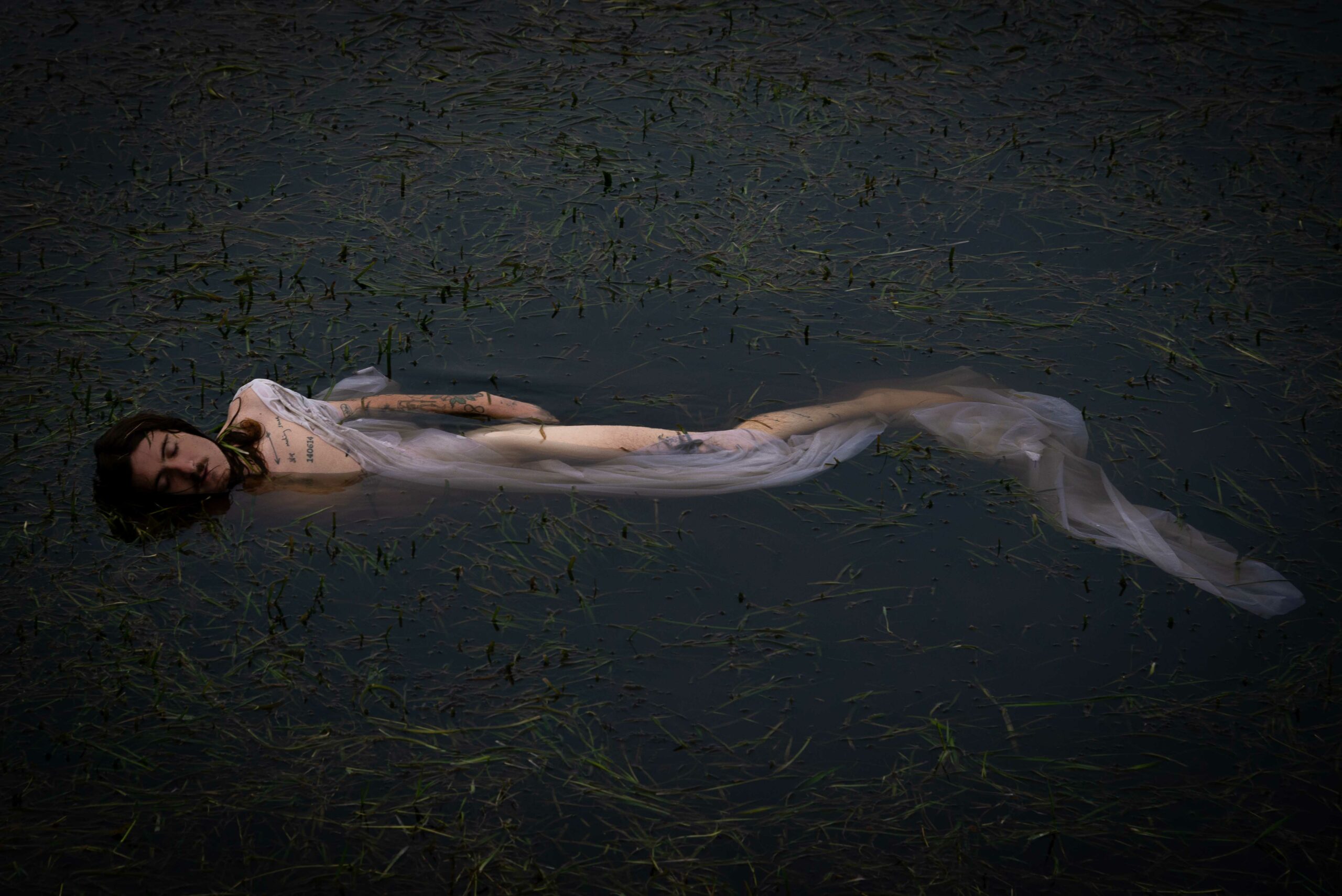
Tia Ranginui (Ngāti Hine Oneone)
Untitled 2022
archival ink on Hahnemühle Photo Rag Smooth paper
Courtesy of the artist
Tia Ranginui was the recipient of the 2016 Belton, Smith & Associates Ltd Highly Commended Award and the 2021 Article & Vernon Money Poppins Excellence Award
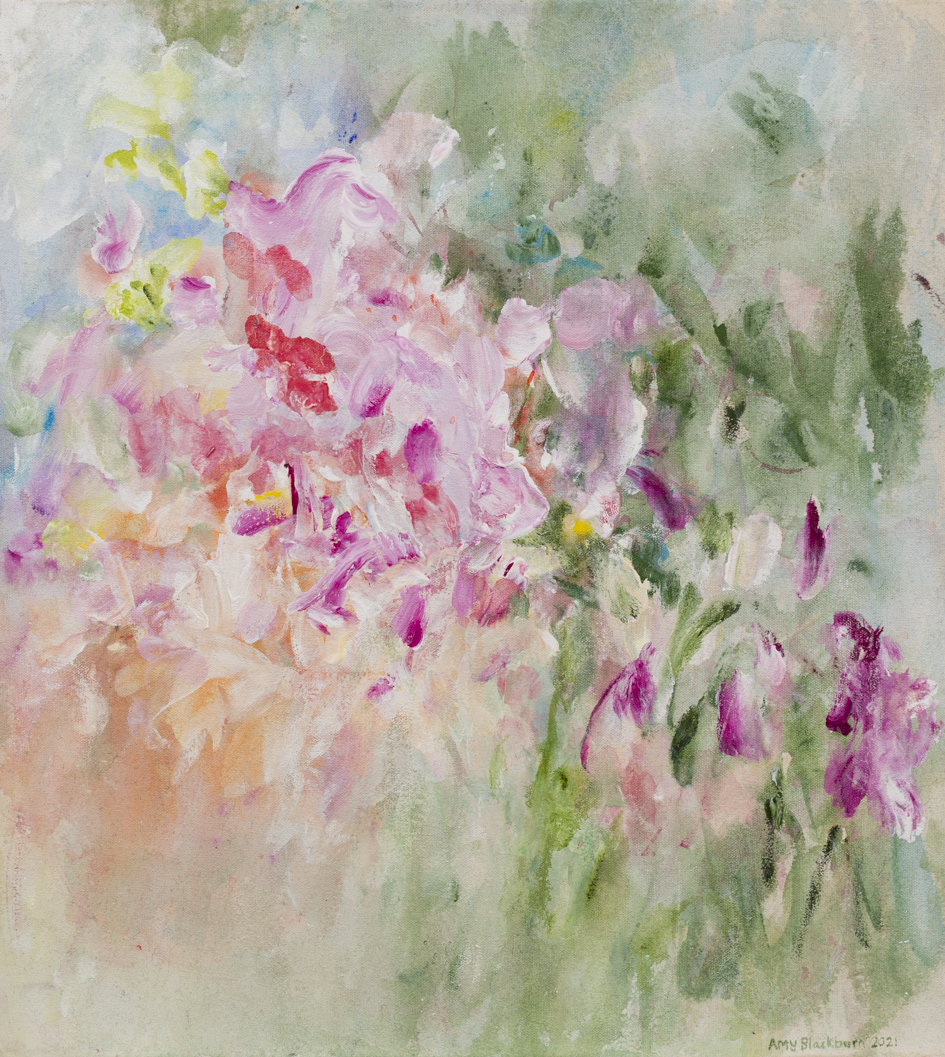
Amy Blackburn
Blooming Bloom’n 2021
acrylic on canvas
Courtesy of the artist
“My award-winning painting Homeward Bound was originally
painted for my first solo exhibition, which happened shortly after
graduating from the Quay School of the Arts, Whanganui UCOL.
Receiving this award gave me added confidence in my painting
style and direction in art making.
My current art practice continues to be inspired by the uplifting
experience of nature, in particular the garden. I am interested
in exploring paint application. An experimental play between
canvas, gesso and paint in pursuit of creating a sense of light in
my work that also suggests botanical references. Gather Together
and Blooming Bloom’n are paintings from my most recent solo
exhibition that showcase my development as a painter since
winning the award in 2017.
The current pandemic imposes vast challenges for the art
community. But it is always worth digging deep if you can produce
artwork out of times of struggle and adversity.”
Amy Blackburn was the recipient of the 2017 Belton, Smith & Associates Ltd Highly Commended Award
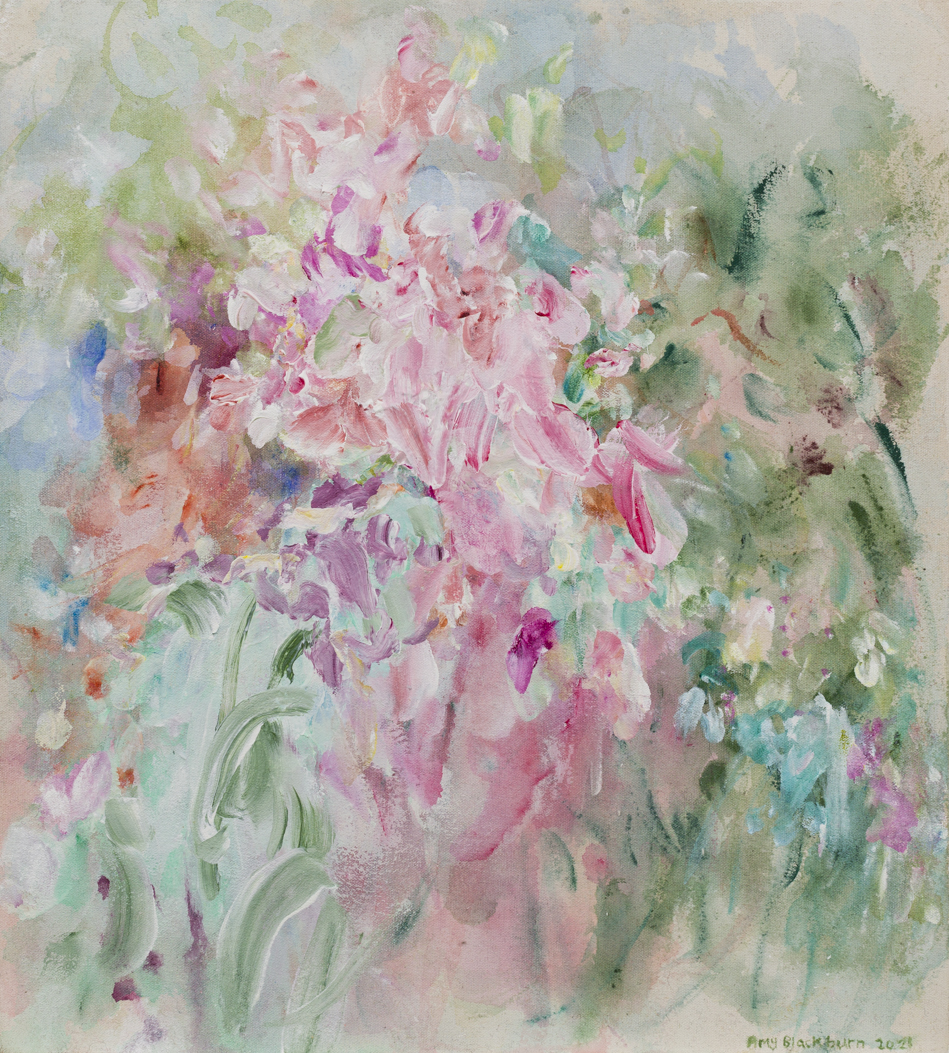
Amy Blackburn
Gather Together 2021
acrylic on canvas
Courtesy of the artist
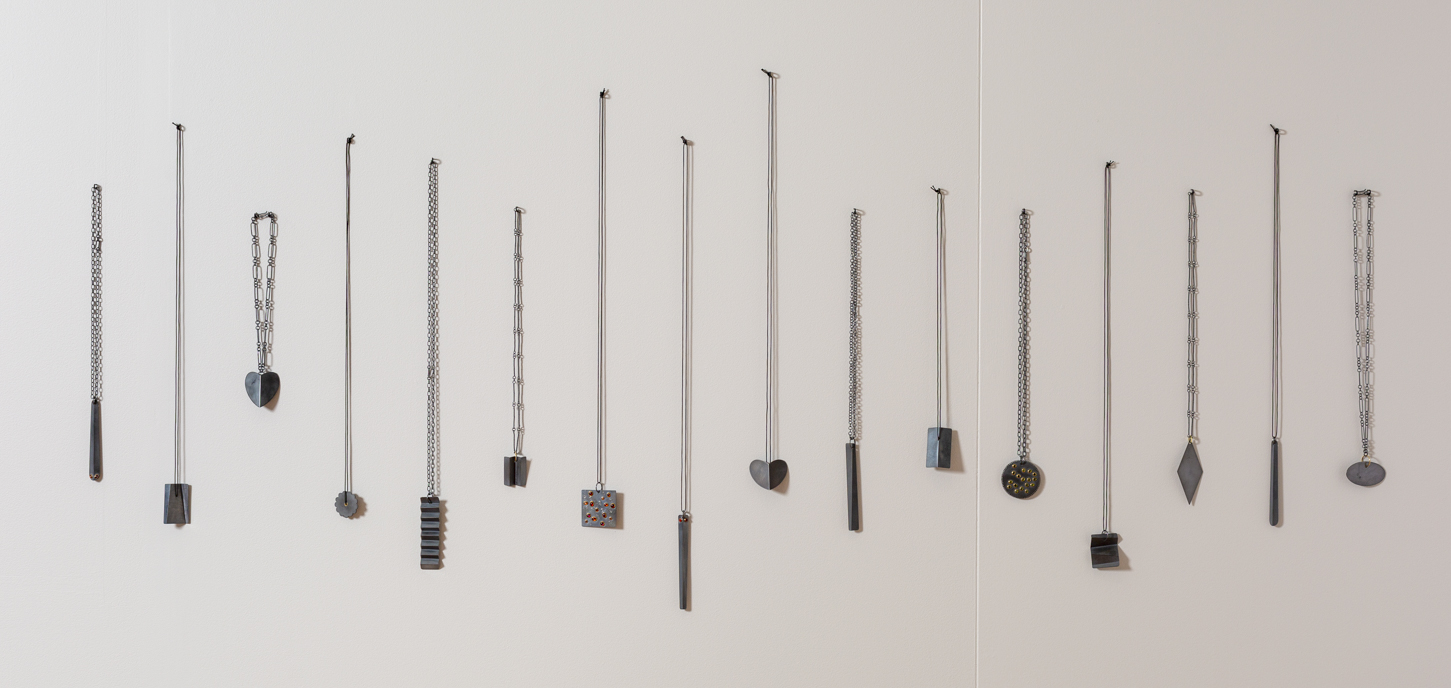
Frances Stachl (Ngāpuhi)
Mita (Dialect, rhythm, intonation) 2022
oxidised sterling silver, 24 karat gold, 18 karat gold, jade
(provenance unknown), garnet, carnelian (16 pieces)
Courtesy of the artist
“Sometimes the way I work feels like developing a personal
language. I draw from my own previous mahi (work) and also from
a range of other sources. My practice sits within a continuum,
I can’t ignore the jewellery/adornment traditions before me,
and I can’t separate the process of making jewellery from the
relationship of jewellery to the body.
I think of making as a means of working through an idea or
thought, asking a series of formal or informal pātai (questions).
A craft practice is a process of exploration, or curiosity, if I knew
exactly what the end result was going to be, I’m not sure it would
be as interesting to me. (Why ask a question if you already know
the answer?)
This body of work is different from my usual, in that I generally
make necklaces that are constructed with units, rather than
pendants on cord or chain. Which I see as being distinctly
different. A pendant feels more like a pointed exclamation mark,
where a necklace is constructed with a series of points that relate
to each other.”
Frances Stachl was the recipient of the 2016 Belton, Smith & Associates Ltd Highly Commended Award and the 2017 Belton, Smith & Associates Ltd Highly Commended Award.
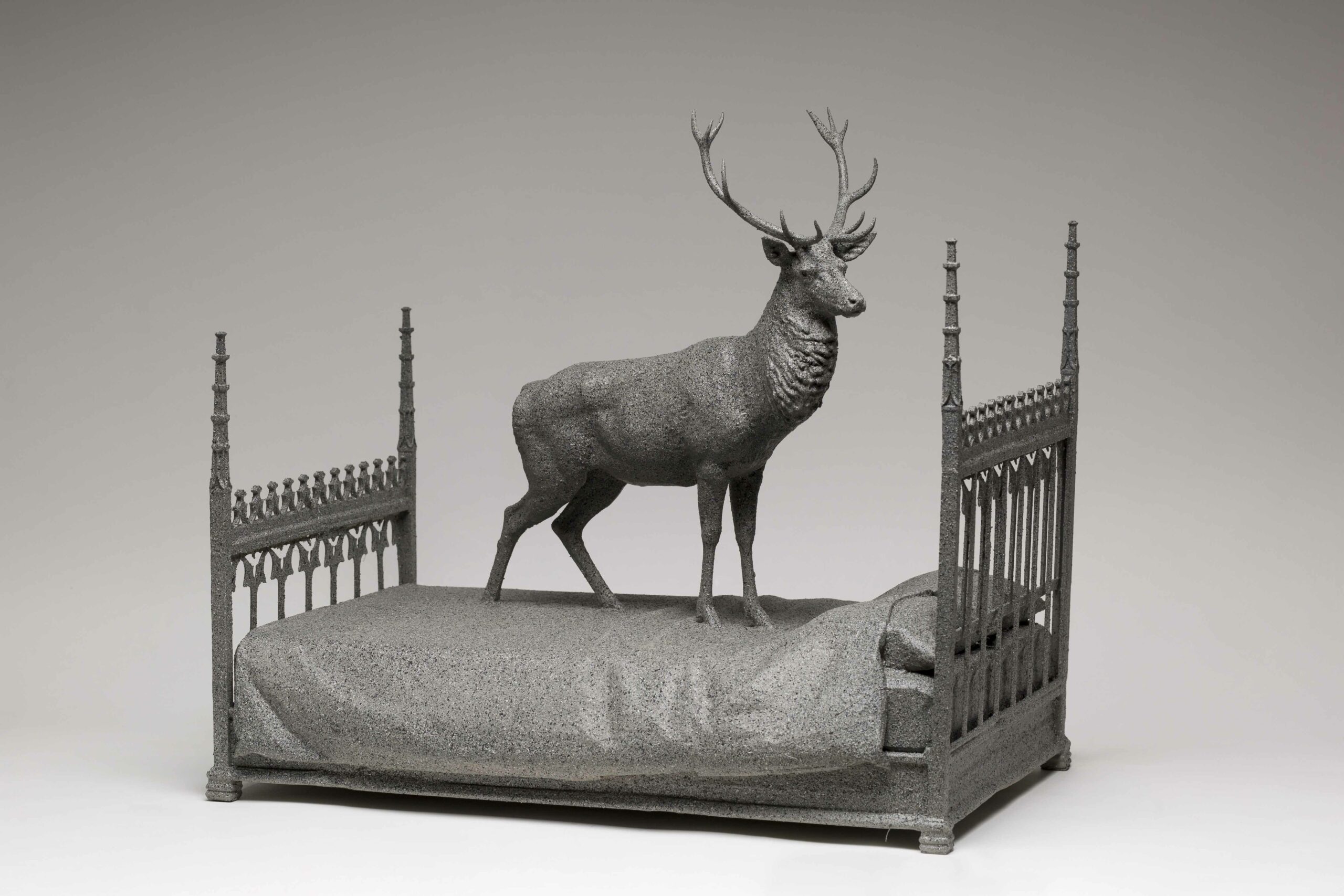
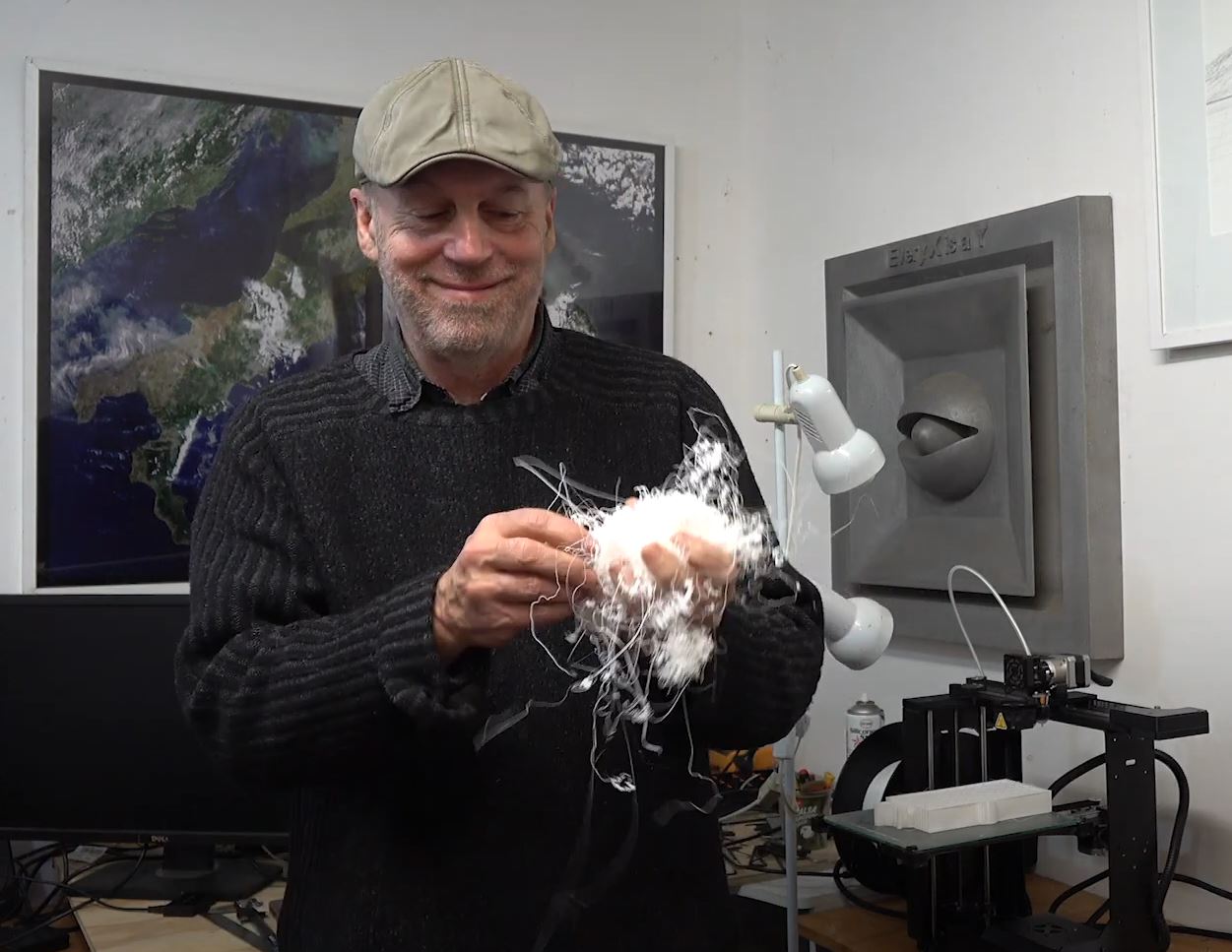
Brit Bunkley in his studio. Photo supplied.
Brit Bunkley
How They Dream 2022
PLA plastic, epoxy and paint
Courtesy of the artist
“My work is ever evolving, following similar threads for twenty years,
and some themes (particularly architectural art) for forty years. I am
intrigued by the intersection of virtual and physical sculpture and the
juncture of animation and captured video. My practice explores an
oblique sense of paranoid apocalyptic fear tempered with a sense of
whimsy and irony. The content is conditioned by a deep interest in
politics, the environment and history.
Since the late 1990’s I have been creating video tableaus that combine
3D renderings with actual footage with video installations and single-channel screenings that have been included in such venues as the
Centre Pompidou, Paris, the Moscow Museum of Modern Art, Haus
der Kulturen der Welt, Berlin and the White Box in New York City. The
computer has been a natural vehicle for creating my artwork, not
only as a tool for the design and dimensioning of sculpture but as a
means towards creating virtual sculpture, photography and digital
video. Recent sculptural work includes the use of gold leaf on 3D print
tableaus of 3D scanned ruined landscape and shrapnel and bullet-pocked walls from war zones. I have also been collaborating with
Andrea Gardner making sculpture from 3D scans of animals.
This new work began during the first lockdown when deer came to our
paddock in droves. I had seen them occasionally on the road, but I had
never seen so many deer in my life. Deer have a mixed reception in New
Zealand, where they are not native. They are sometimes perceived not
as wild animals of beauty but as a pest destroying native growth. I had
photographed several backgrounds for my video here, but decided, in
the end, to use dramatic Southwestern American landscapes from a trip
to the US in 2021.
Pillar of Fire uses its biblical reference as a trope of catastrophic
climate change. During our 2021 trip we witnessed the wildfires in
a year of endemic climate anomalies, only to return to the apparent
tranquility of New Zealand. This video is a digital collage consisting
of 3D drone scans, digital animations, green screens, alpha channels
and 4k footage. I have used green screen deer, audio and music from
Pond5 and Shutterstock. Stop motion wildfire clips courtesy of Arnav
Kainthola. The sculpture How They Dream is a surreal offtake from the
video using a 3D scan of a taxidermied deer.”
Brit Bunkley was the recipient of the 2017 Belton, Smith & Associates Ltd Highly Commended Award
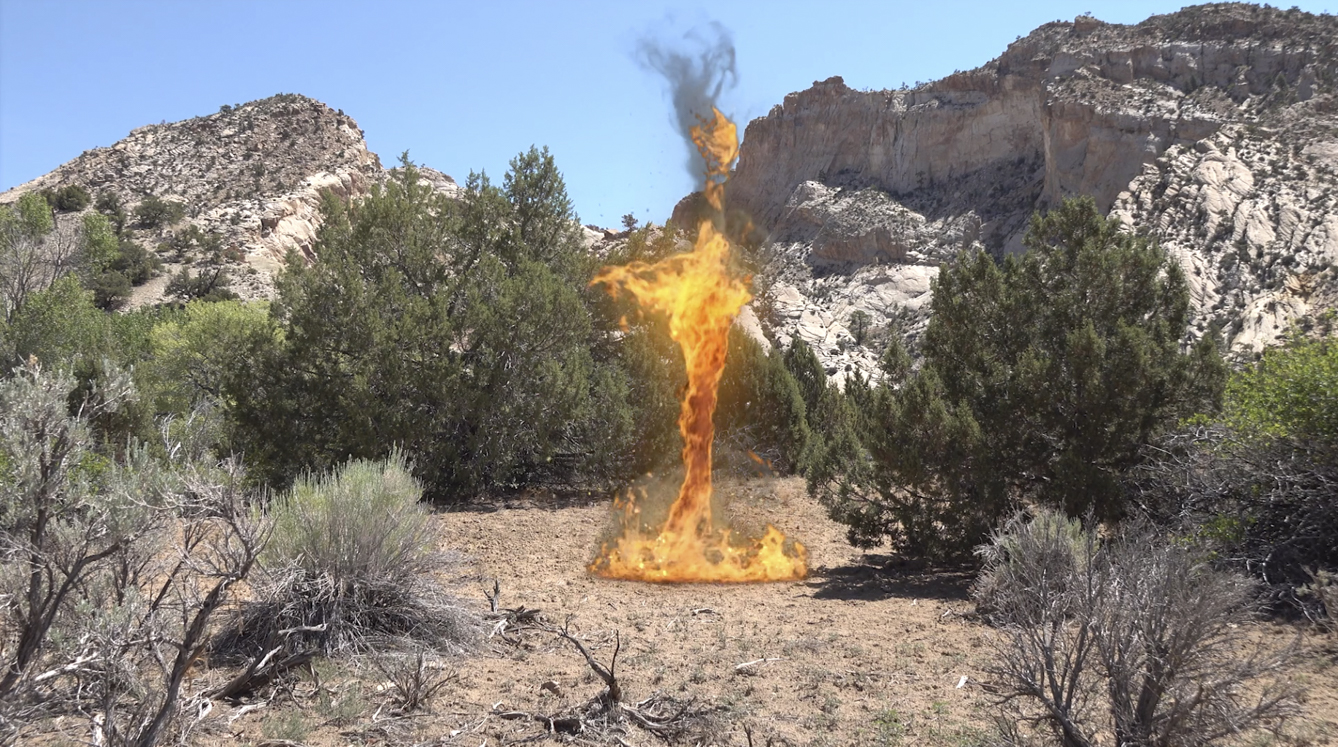
Brit Bunkley
Pillar of Fire 2022
video
Courtesy of the artist
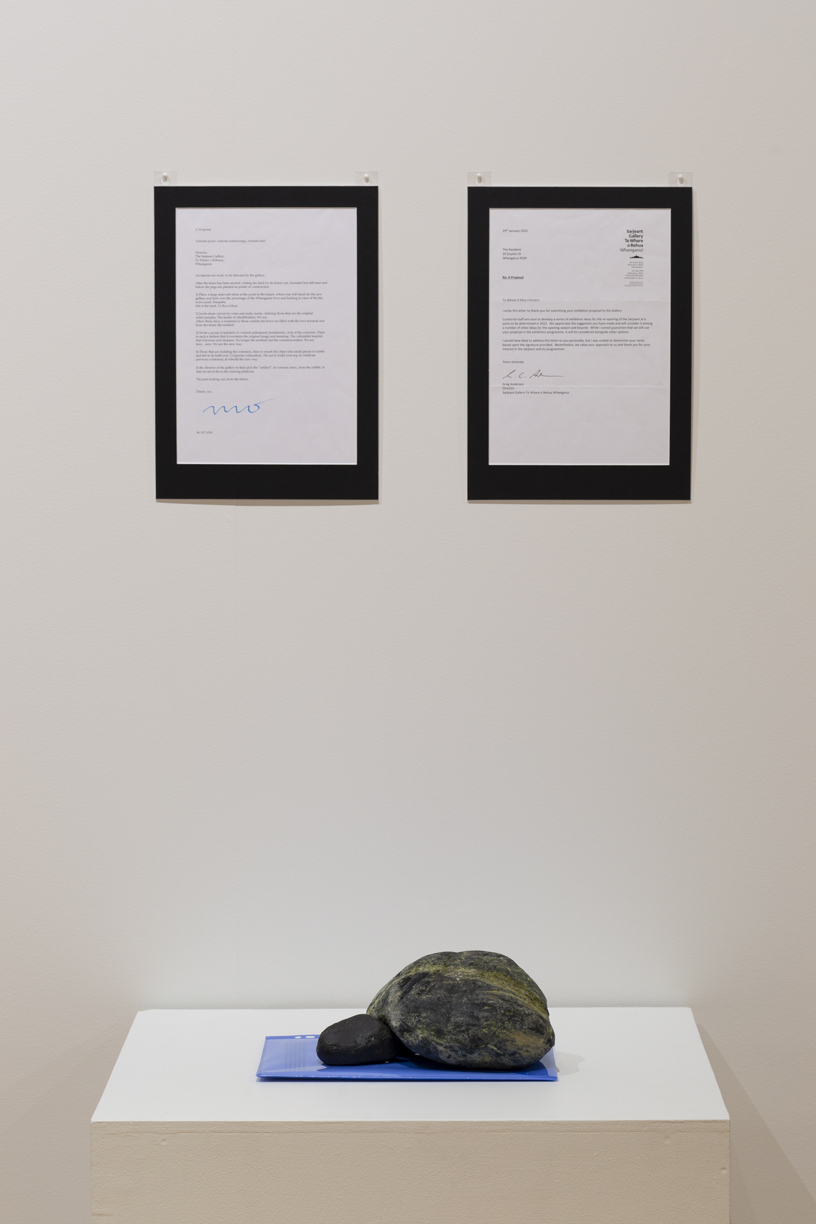
Lee Morgan
We Are the Fruits of Our Past
January 2020 – January 2022
mixed media
Courtesy of the artist
“Language is very powerful. Language does not describe reality.
Language creates the reality it describes” Desmond Tutu
My practice is liquid. Like a river; the same but not the same river
as yesterday.
Since the award of a painting based on the interpretation of
teabags which had been placed loosely on the canvas ground my
practice has varied.
A return to situation-based art saw the development of the
proposal which is now featured in this present work. The
description is the artwork.
The advent of a wall around the Sarjeant Gallery Te Whare o Rehua
site gave birth to visual graffiti, and the unforeseen closure of
New Zealand made for COVID works on brown paper. The only
difference in my view concerning COVID and the visual arts is that
galleries/art promoters may construct a timeline of specificity. In
our COVID times the art making by artists hasn’t ceased, hasn’t
changed; the only real change is collecting in groups.
Three circles, 5/7/5 lines. Boredom created change, a need to
find a new ‘something’. Works based around 3 circles, 5/7/5 lines
conceptually “Blues’n’haiku” abstract interpretation.
An invitation. The new work called We Are the Fruits of Our Past a
reconsideration of corporatism.
“Art is a kind of confession, more or less oblique” James Baldwin
Lee morgan was the recipient of the 2018 Central City Pharmacy Excellence Award.
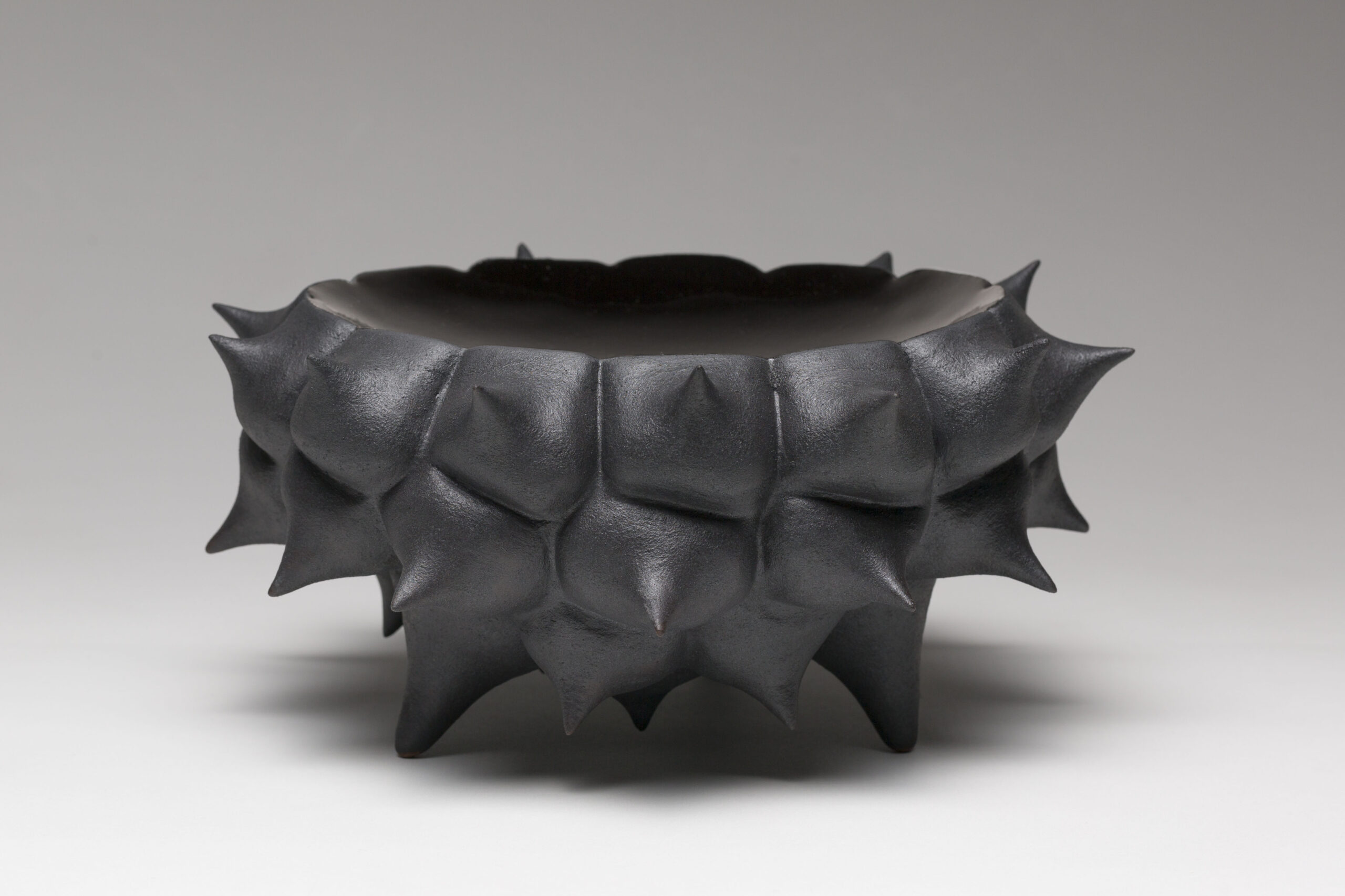
Rick Rudd
Bowl 2021
handbuilt terracotta
Courtesy of the artist
“Most of my work over the past twenty years has taken its
inspiration from the ‘tea pot’, but from time to time I make works
based upon other domestic vessel forms. These three works are
based on the idea of a bowl.”
Rick Rudd was the recipient of the 2019 Dalgleish Architects Excellence Award

Rick Rudd
Bowl 2021
handbuilt terracotta
Courtesy of the artist
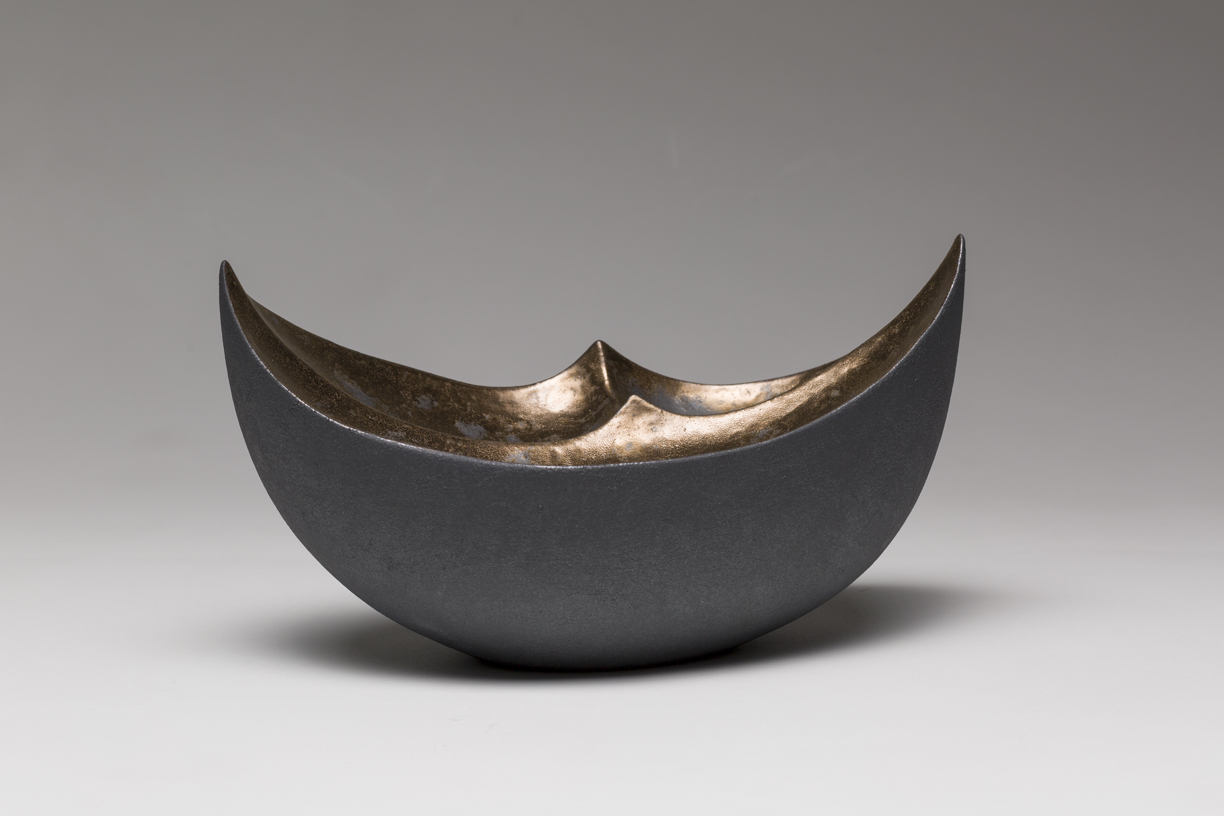
Rick Rudd
Bowl 2022
handbuilt terracotta
Courtesy of the artist
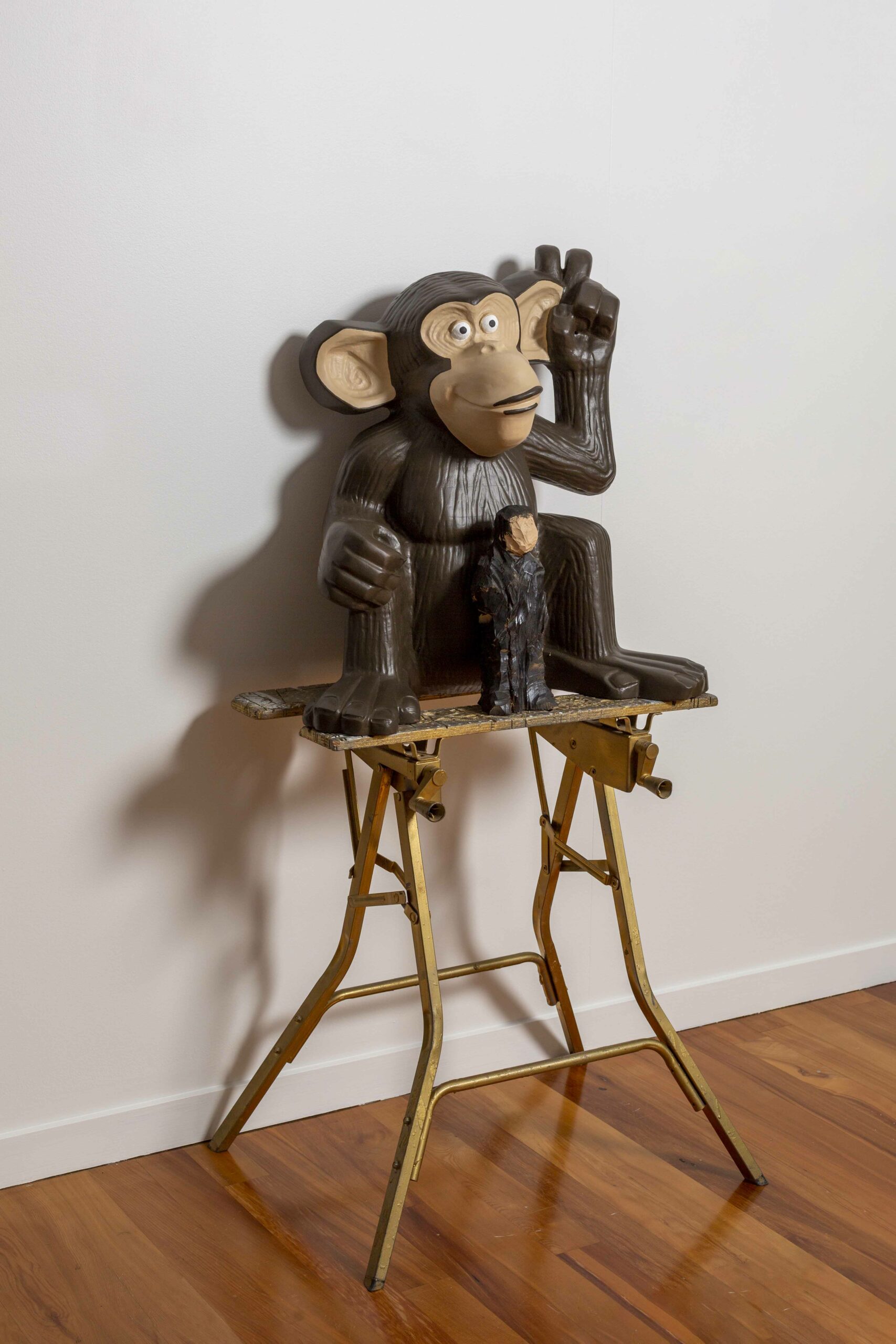
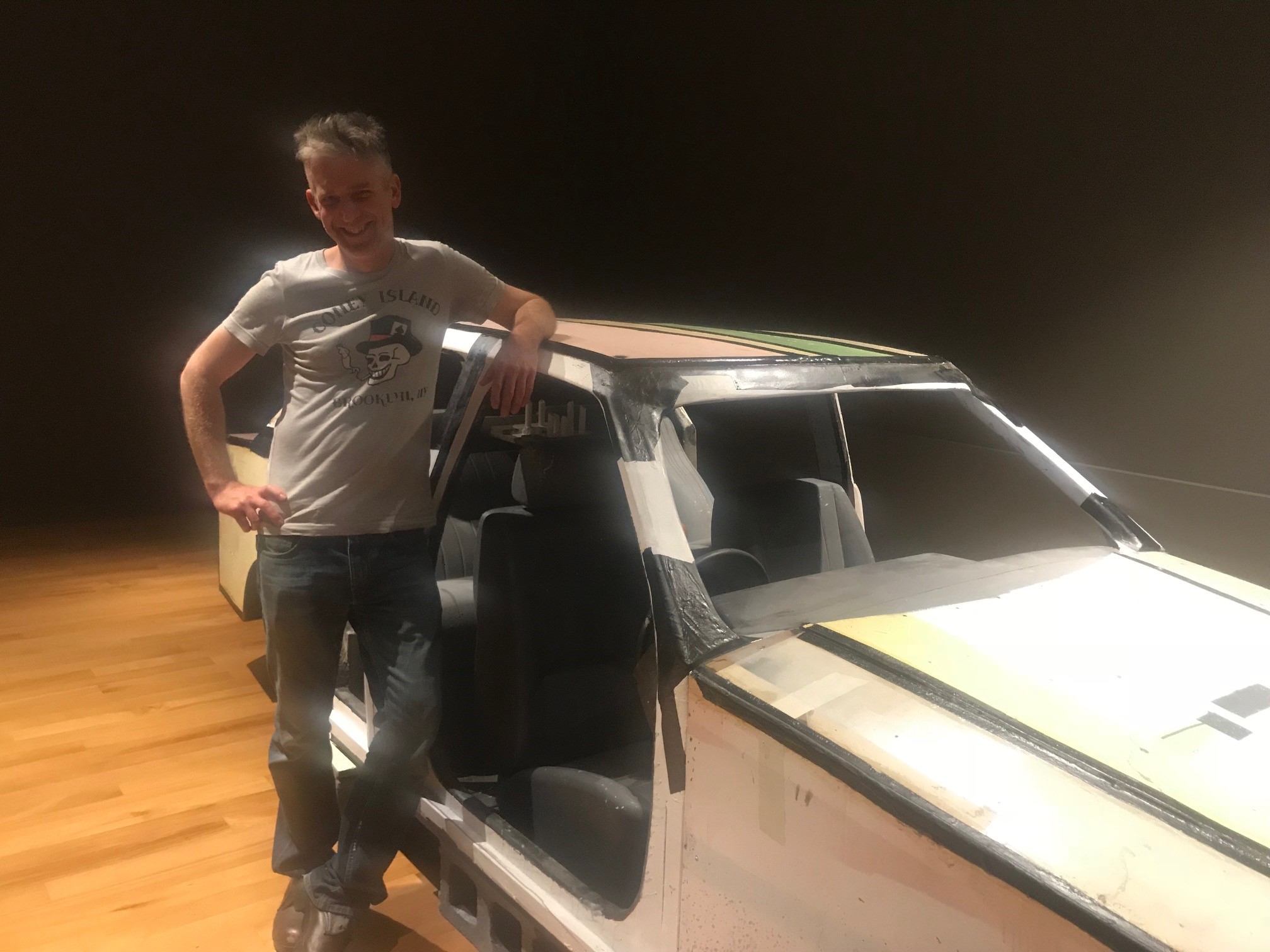
Glen Hayward
Glen Hayward
Monkey Boy 2020
offcuts and paint
Courtesy of Paul Nache
Glen hayward was the recipient of the 2019 Central City Pharmacy Excellence Award.
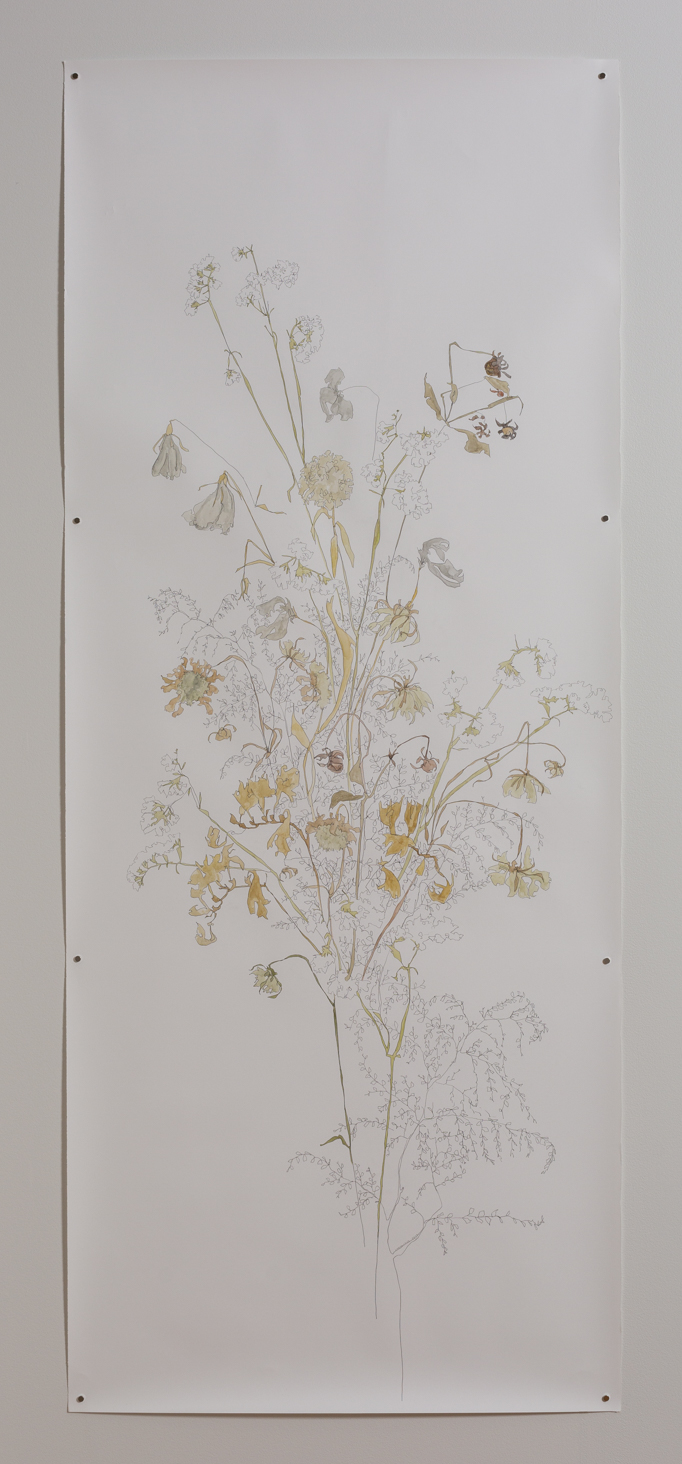
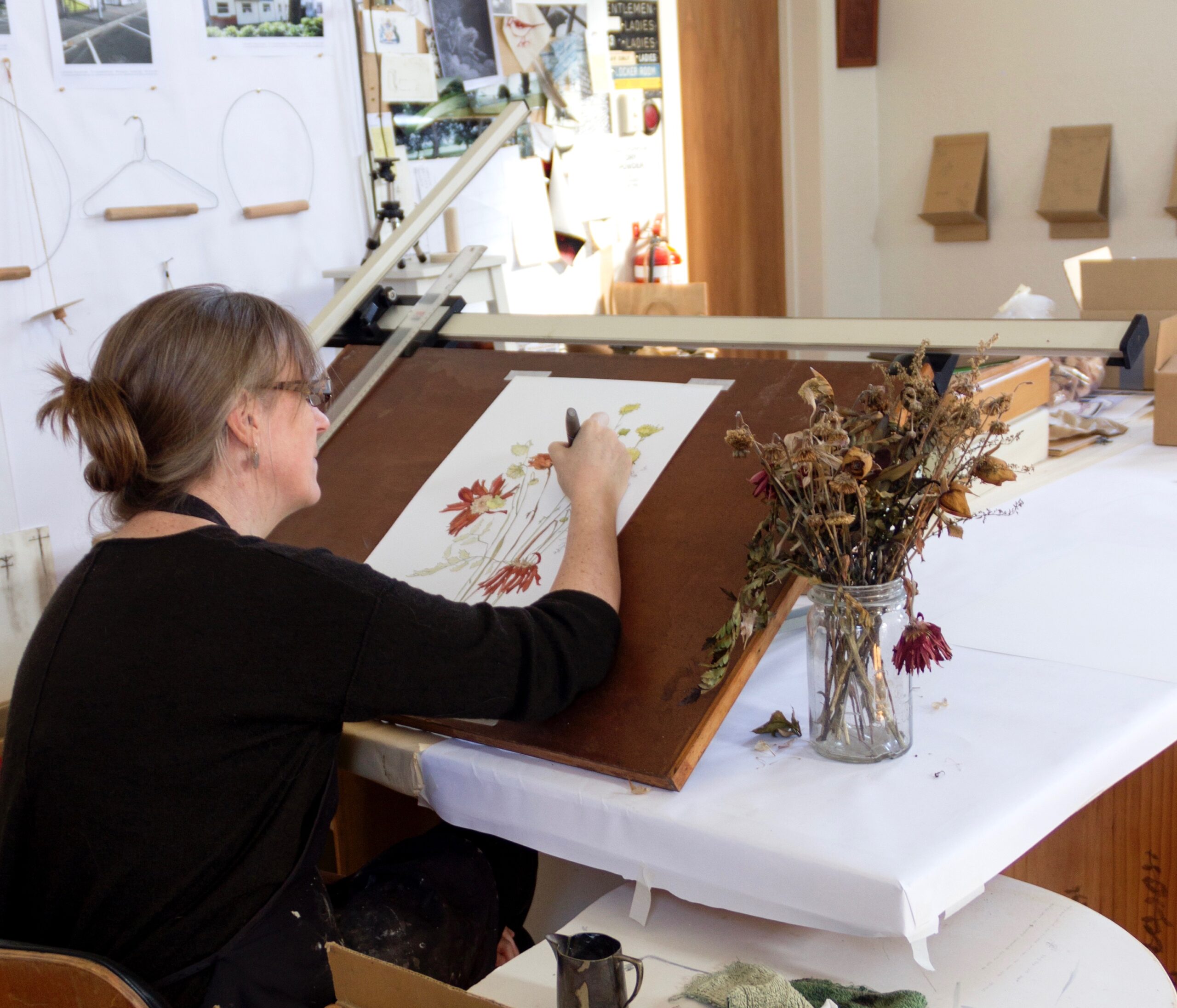
Catherine Macdonald at work in her Whanganui studio. Image by Liquid Edge.
Catherine Macdonald
Untitled III 2022
pencil and watercolour on paper
Courtesy of the artist
“My work changes quite a bit, I jump around in different media –
drawing, printmaking, furniture and writing. Ideas will often
reappear in different media, looked at from different angles. These
large scale botanical works are a departure from my award winning
work Just a Moment, which comprised muiltiple smaller works and
text, but there are similarities. They are pencil and watercolour and
in their own way are inspired from my own environment.
I like to draw from life, sometimes this is slightly removed by
being drawn from photos as in the case of Just a Moment. These
drawings were drawn with the flower stalk held in one hand
and the pencil in the other. A very direct and free process. I then
‘coloured them in’ with watercolour.
Apart from doing these botanical works, I’ve been playing around
with letterpress and woodcut, another way to combine images and
text. For me this is another fun way to make works.
I create botanical works periodically, often after a busy time in the
studio prepping for other shows, when I’m just needing something
relaxing to draw. They are meditative. I keep flowers that have
been given to me, I’ll draw them long after they have past their
‘best’. I like the muted colours in a bunch of dead flowers.
Art always has a couple of roles to play in society. It can be the
mirror held up – recording and reflecting what is happening –
provoking and prodding or it can be a means of escape a place to
rest the eyes a reminder of peaceful times. Both of these roles are
important now.”
Catherine Macdonald was the recipient of the 2020 Article & Money Poppins Excellence Award.
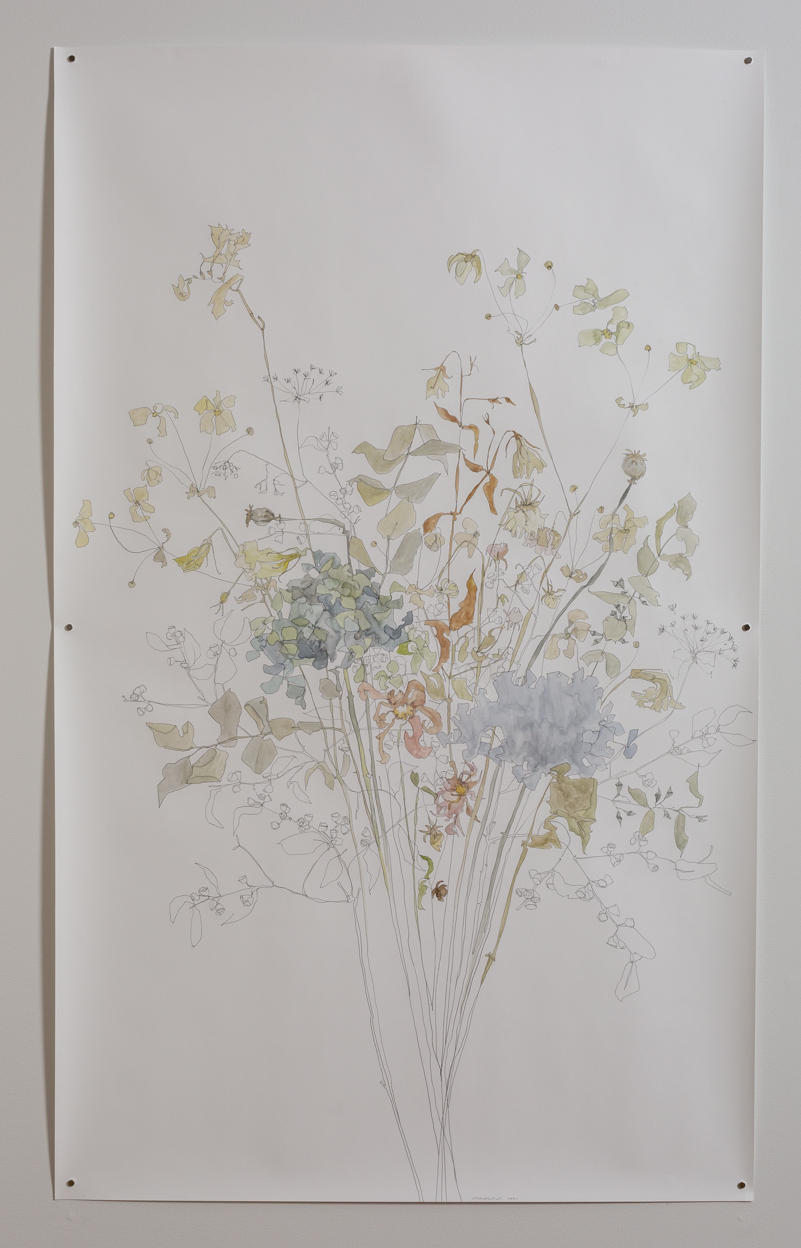
Catherine Macdonald
Arrangement 2021
pencil and watercolour on paper
Courtesy of the artist
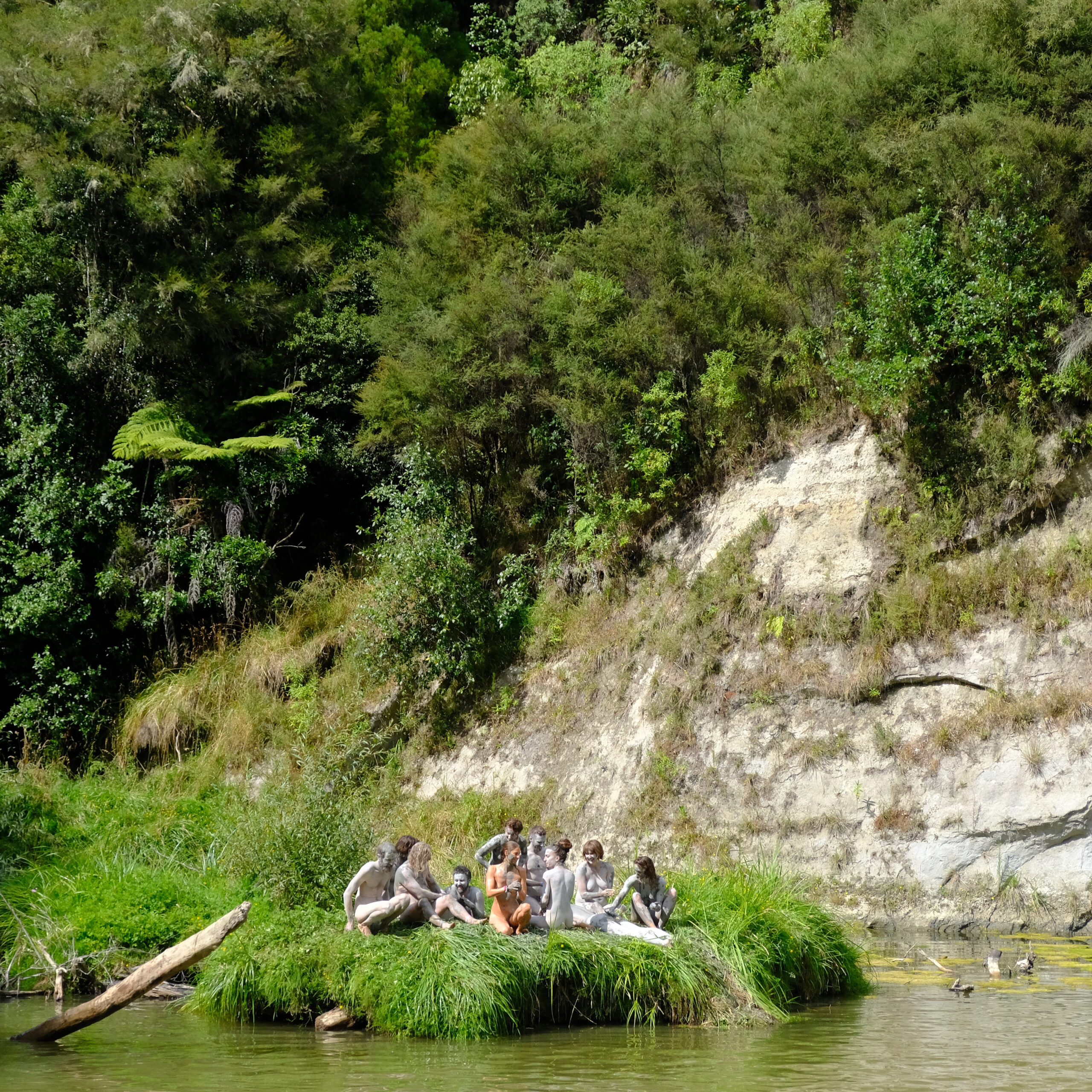
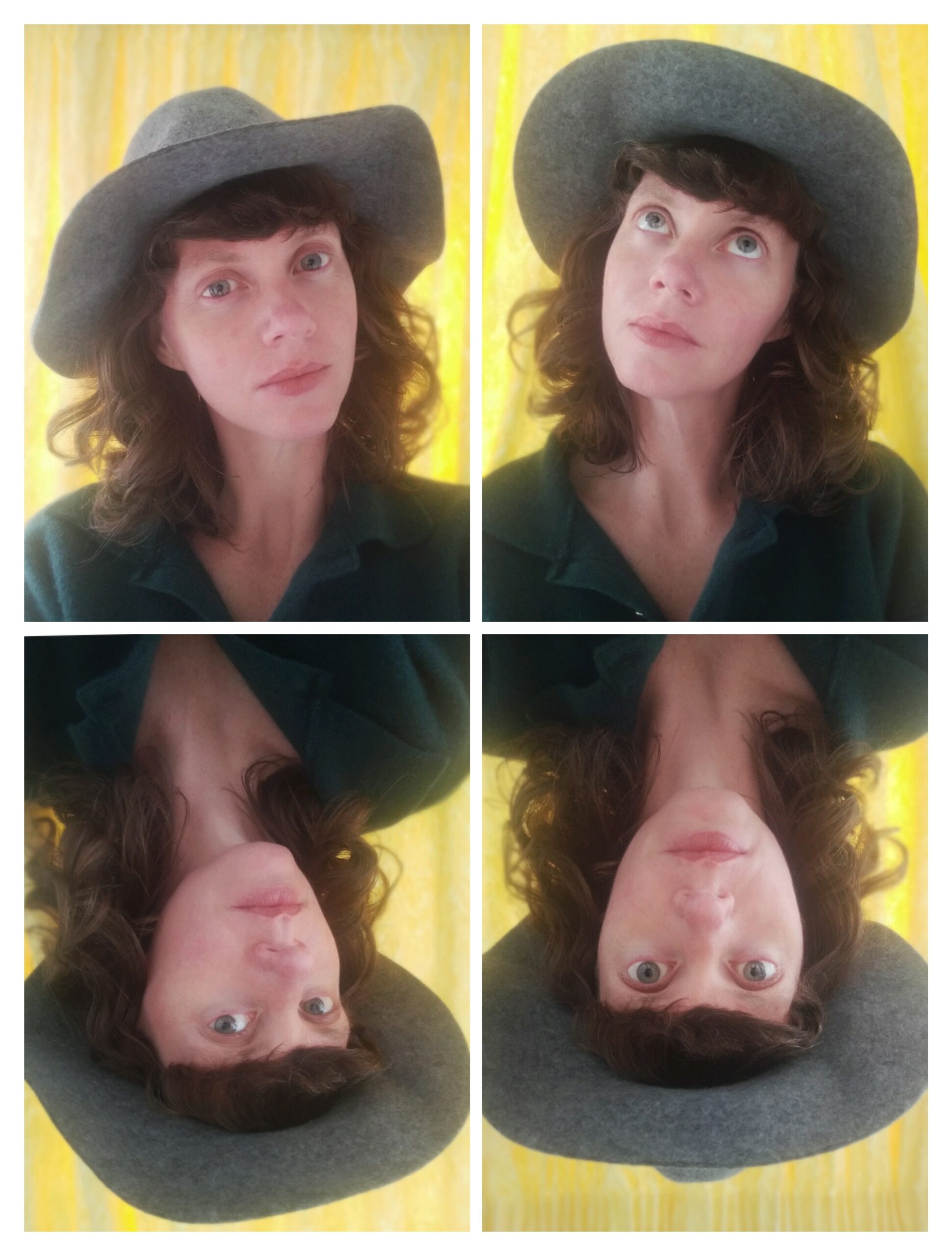
Brydee Rood. Image supplied.
Brydee Rood
Island Is Land We Land 2022
installation
Courtesy of the artist
Island Is Land We Land
Sunday after Friday
It is the Papa rock, the Papa of Papatūānuku
Wet from the tide of Kai Iwi
Dried, dusted and lost in the crevices of collected bodies,
Embedding under nails
Staining lines between moons
A peppered residue in outer ear canals
Opaque blue-grey bead deliquesce
Seeping away from the parched corners of clotted tear ducts
A cool, firm, clay touch
Yielding warm flesh beneath fingers pressed
Hineahuone, the first mother
A damp Earth vagina
Plum lips kissing the whenua
Melding the island together, a resounding chorus of rising breath
Embodying an ethereal call to the Patupairehe
Baked and flaking as morning sun shadows slip away
Fresh smears over pale skin and copper beards
Dust! The smoothest, finest, purest 15 million years in formation anient
Ghost of unconsolidated soil uplifted, crumbling
Over caking nipples exposing pinker pinkness within
Darker when moist blue-grey colour of our endangered kōkako
Papa rock clay
Haunting songs of extinction. Can anything be saved?
Bare feet on an island, in the Mangamahu Stream, on an island
On an island
Which spells fill your boots? Left on entering my tent
Legs stretch out the open fly
Flapping zippers unzipped
Under a starry, electric avalanche, Milky Way sky
A place where tongues meet
The tongues of the present, the tongues of our consciousness
And maybe the tongues of future harmony
Saving us from something
Somewhere in nowhere, over the Mangamahu Bridge
Beyond time
For a hushed, sustained and gentle nap
Tuesday after Sunday
Brydee Rood was the recipient of the 2020 Dalgleish Architects Excellence Award
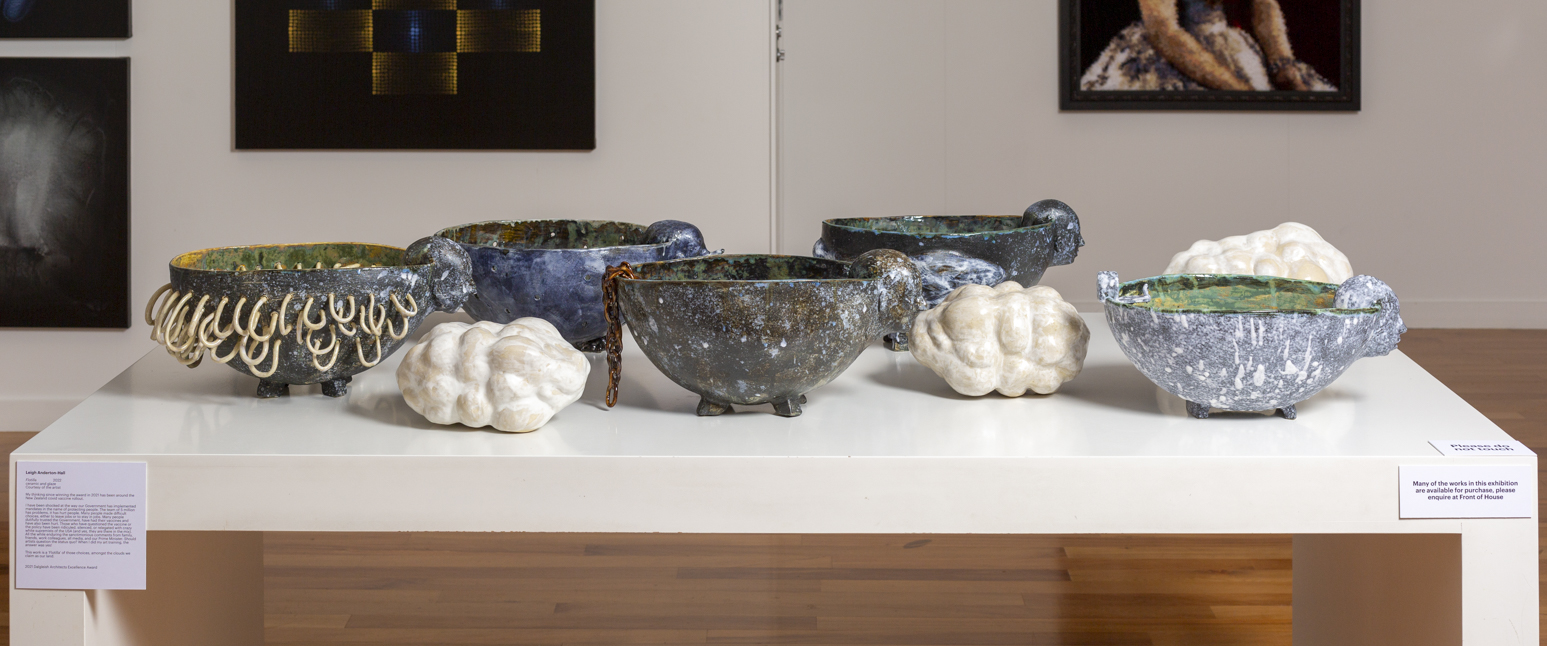
Leigh Anderton-Hall
Flotilla 2022
ceramic and glaze
Courtesy of the artist
“My thinking since winning the award in 2021 has been around the
New Zealand covid vaccine rollout.
I have been shocked at the way our Government has implemented
mandates in the name of protecting people. The team of 5 million
has problems, it has hurt people. Many people made difficult
choices, either to leave jobs or to stay in jobs. Many people
dutifully trusted the Government, have had their vaccines and
have also been hurt. Those who have questioned the vaccine or
the policy have been ridiculed, silenced, or relegated with crazy
white supremists of the USA (and yes, they are there in the mix).
All the while enduring the sanctimonious comments from family,
friends, work colleagues, all media, and our Prime Minister. Should
artists question the status quo? When I did my art training, the
answer was yes!
This work is a ‘Flotilla’ of those choices, amongst the clouds we
claim as our land”
Leigh Anderton-Hall was the recipient of the 2021 Dalgleish Architects Excellence Award.
To buy the limited edition Whanganui Arts in Review poster below, contact the Sarjeant on the Quay shop on 06 349 0506 or info@sarjeant.org.nz

whanganui arts in review
a survey of past award winners 2011 – 2021
26 february – 5 june, 2022
The Whanganui Arts Review has been showcasing the diverse works of talented artists from the Whanganui region for the last thirty four years. As the longest running public arts review in New Zealand, we value this exhibition as a highlight of our annual programme. We also enjoy recognising artists that have made an outstanding contribution to the Review with an array of awards, sponspored by local businesses and our principal sponsor Pattillo. Whanganui Arts in Review is a survey of award winners from the past ten years, 2011-2021.
This year we have moved the Arts Review to November due to programme rescheduling caused by the uncertainties surrounding Covid 19. In its usual place in the calendar, we wanted to offer a glimpse into the current practice of artists who have won either the Open Award of the Review, a Highly Commended or an Excellence Award from the last decade. The resulting selection brings together works by twenty three distinctive artists, and reflects their practice since winning an award.
We have last year’s Open Award winner and Pattillo Project recipient Andrea Gardner represented with her characteristic staged photography, alongside recent photographic works by Tia Ranginui, Brydee Rood, and a video and 3D printed sculpture by Brit Bunkley. The local ceramic community is present in the vastly different works of Leigh Anderton-Hall, Andrea du Chatenier, Rick Rudd, and Angela Tier, displaying the versatility of this wonderful medium. The skilled art of jewellery can be found in a new body of work by Frances Stachl.
Whanganui’s glass community is exhibited with beautiful works by David Murray and Dr Kathryn Wightman, with sculptural and installation works by Tracy Byatt, Glen Hayward, Lee Morgan, Kirk Nicholls and Penni Wyse. Drawing and painting are also well covered with the varied works of Amy Blackburn, André Brönnimann, Katherine Claypole, Catherine Macdonald, Prakash Patel, Mark Rayner and Paul Rayner.
We hope you will enjoy discovering the work of the many accomplished and thoughtful artists who call Whanganui home, and look forward to welcoming you to our annual Pattillo Whanganui Arts Review when we open this ever-popular exhibition later this year.
Jessica Kidd
Assistant Curator
